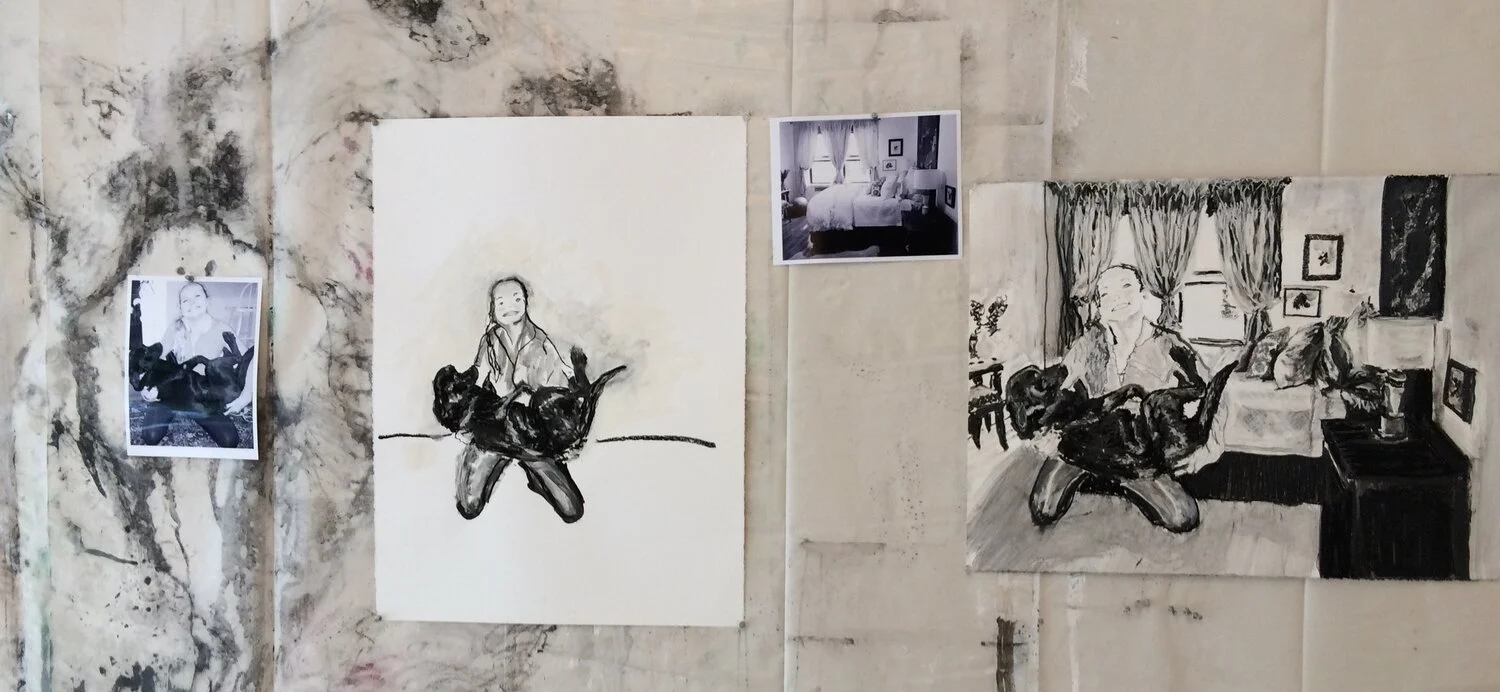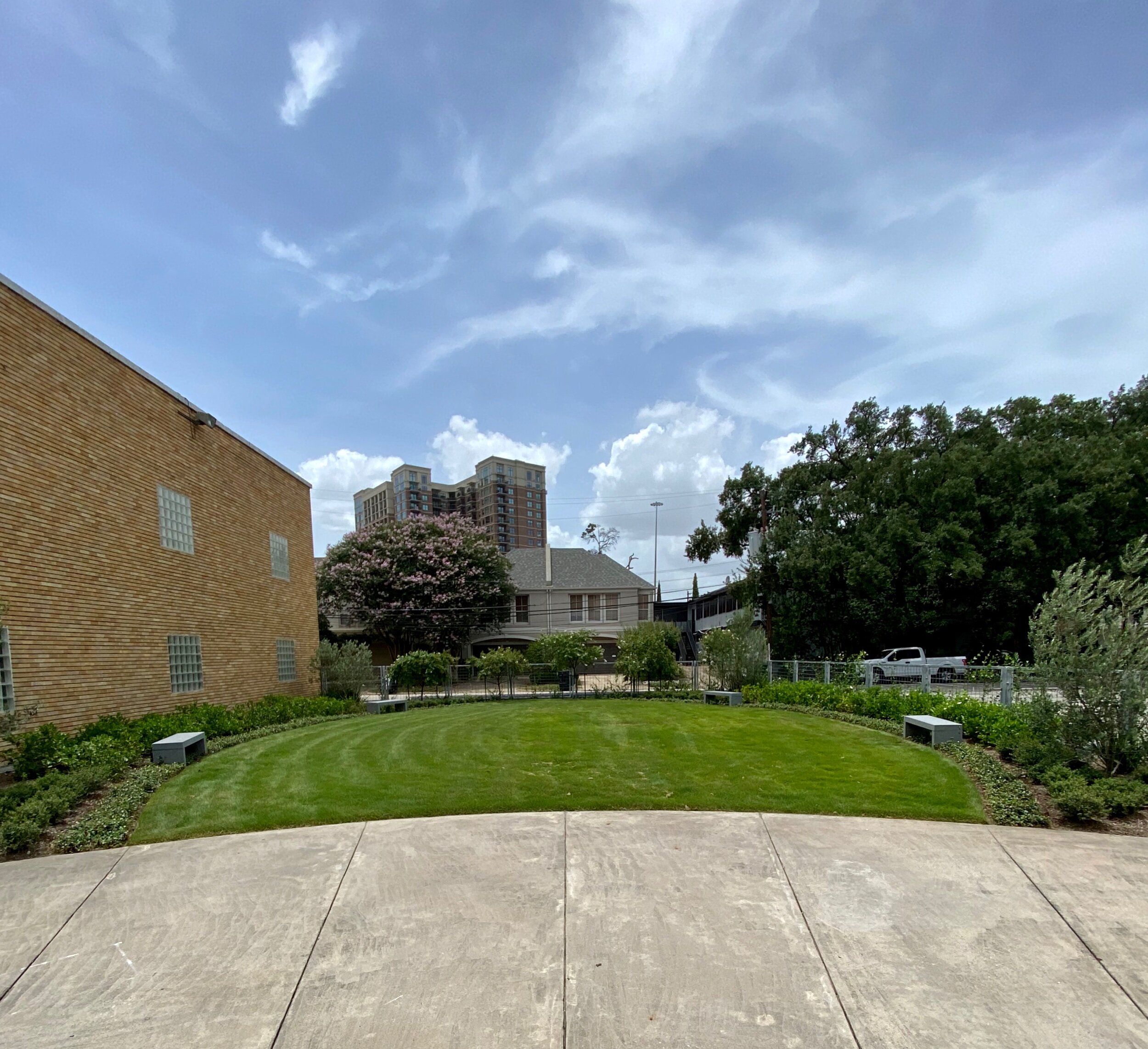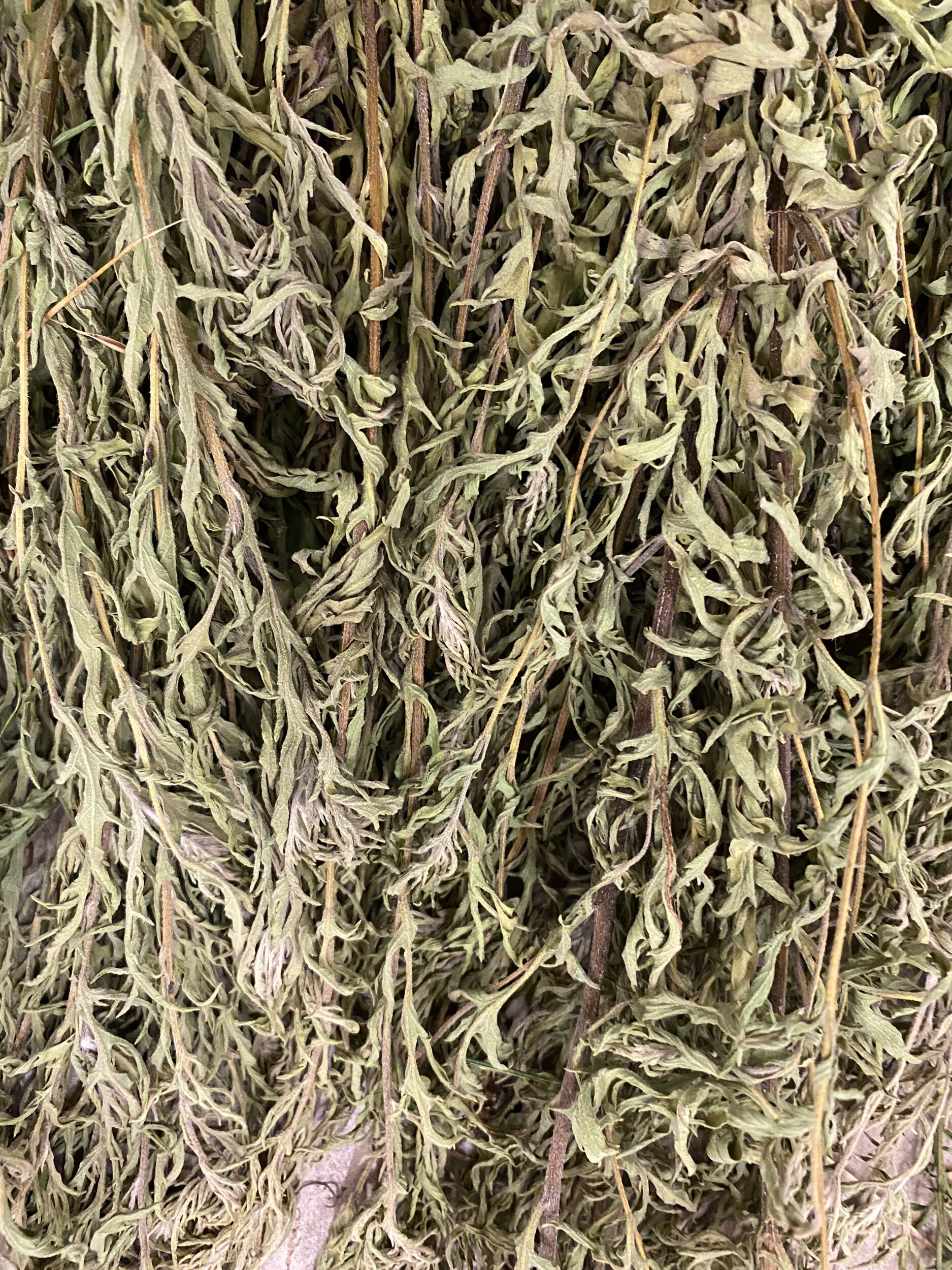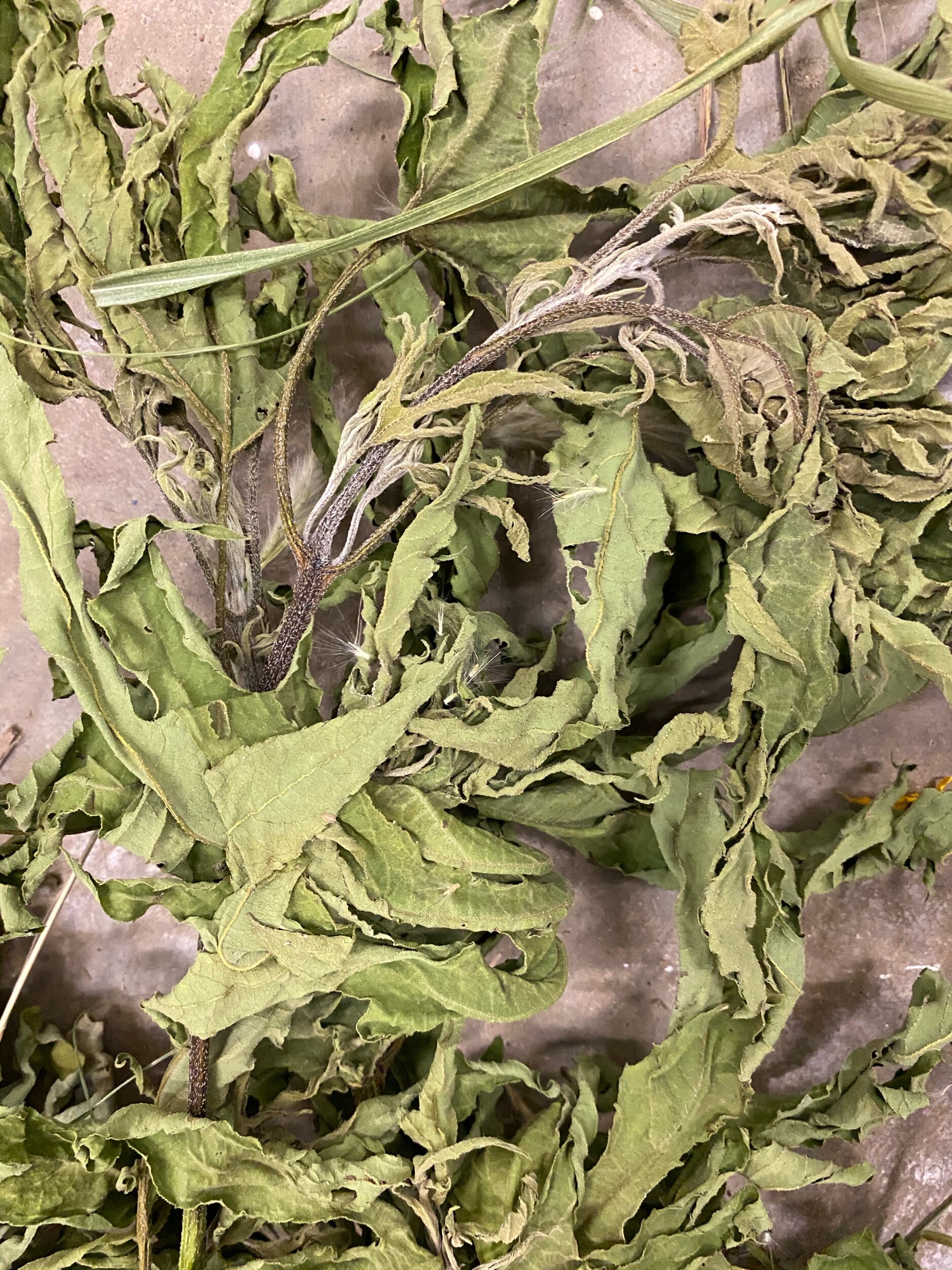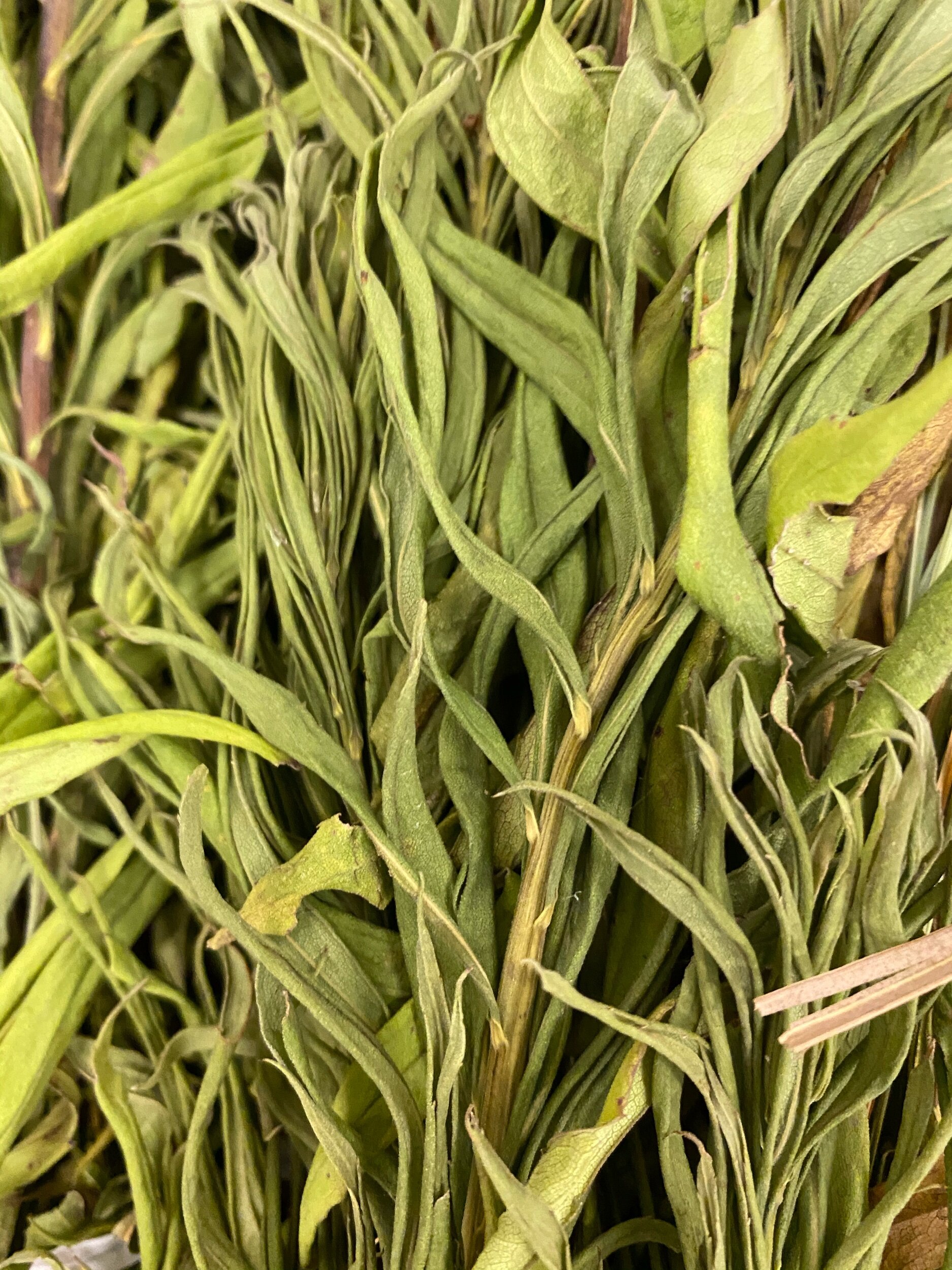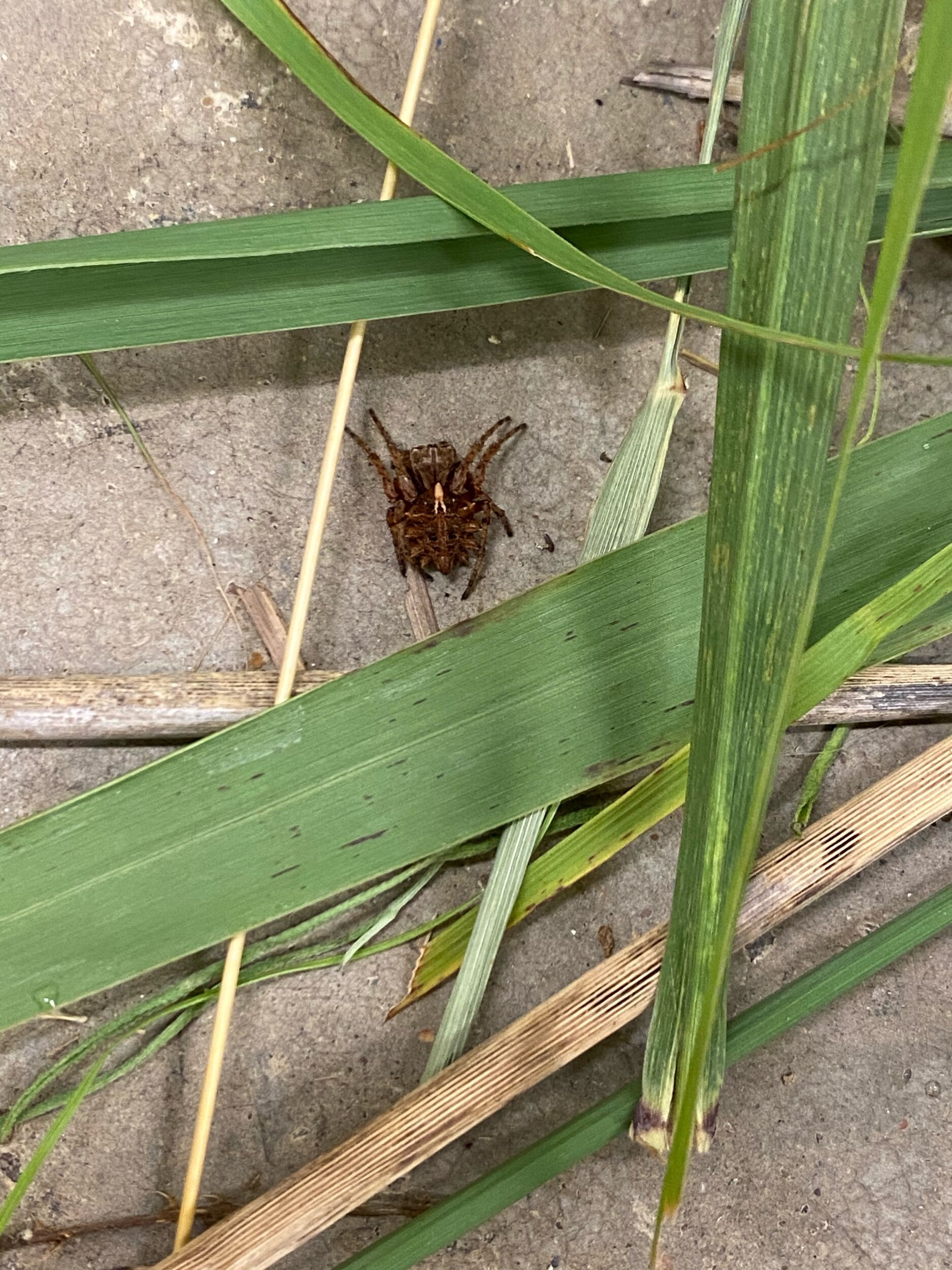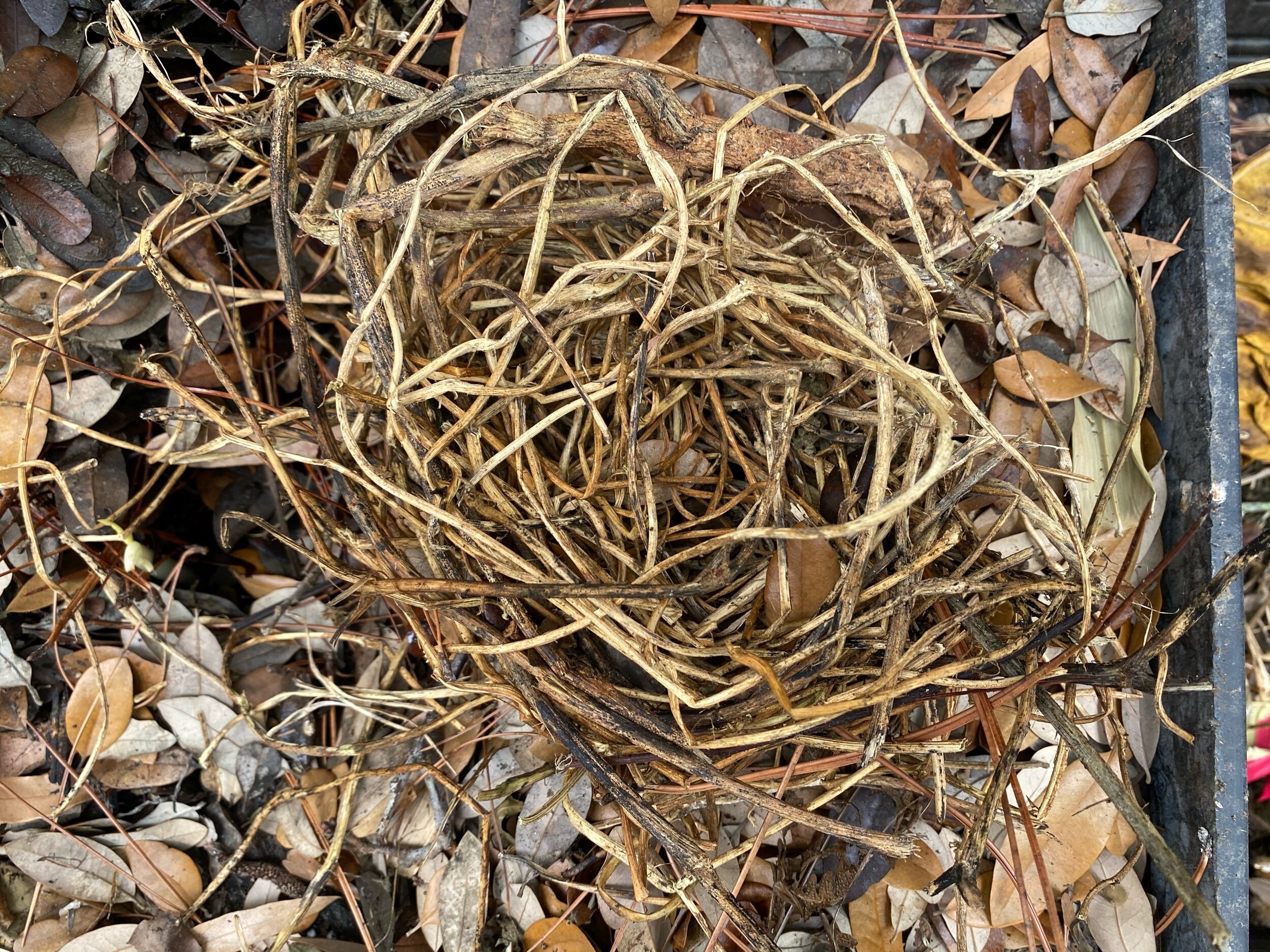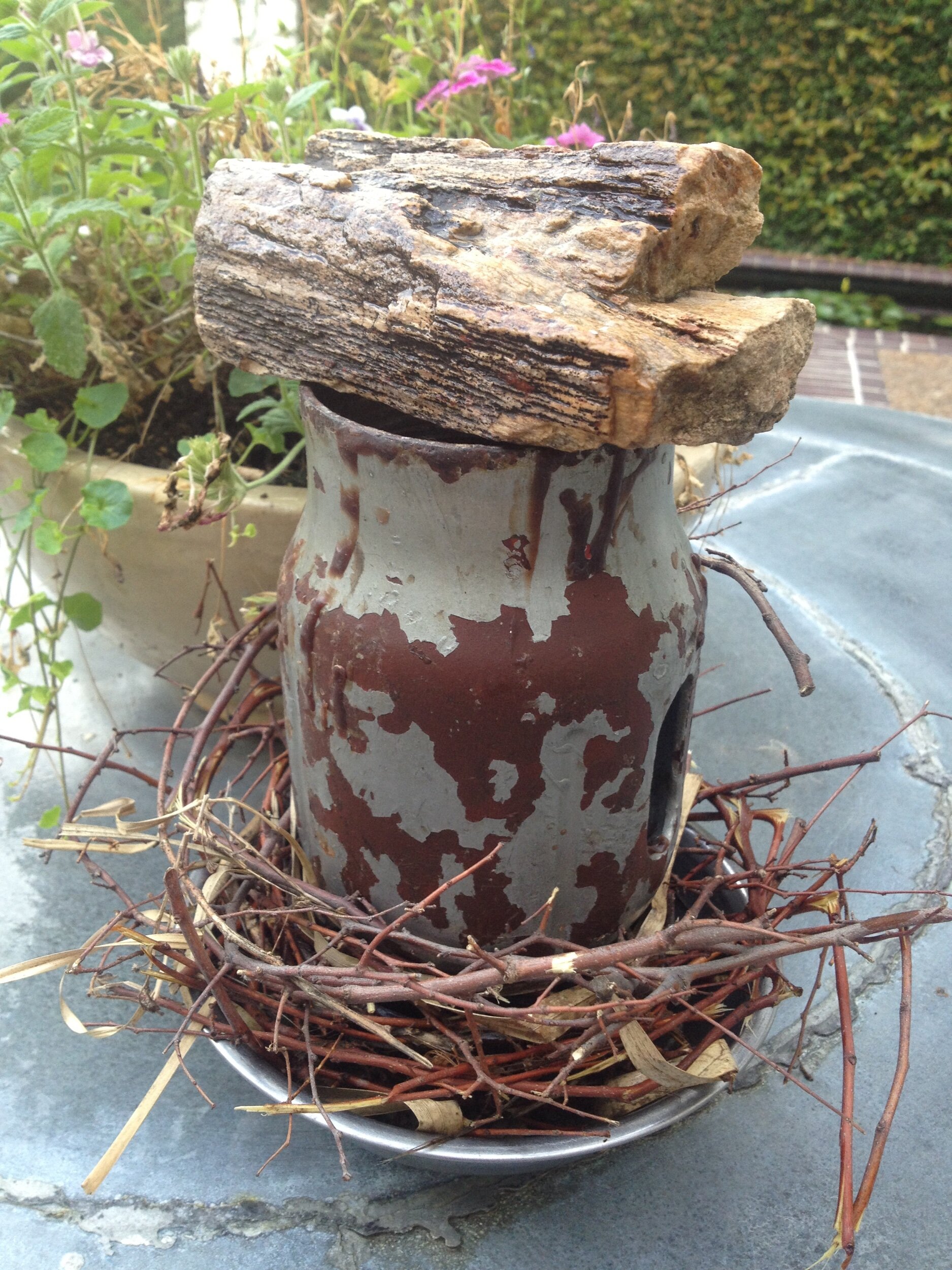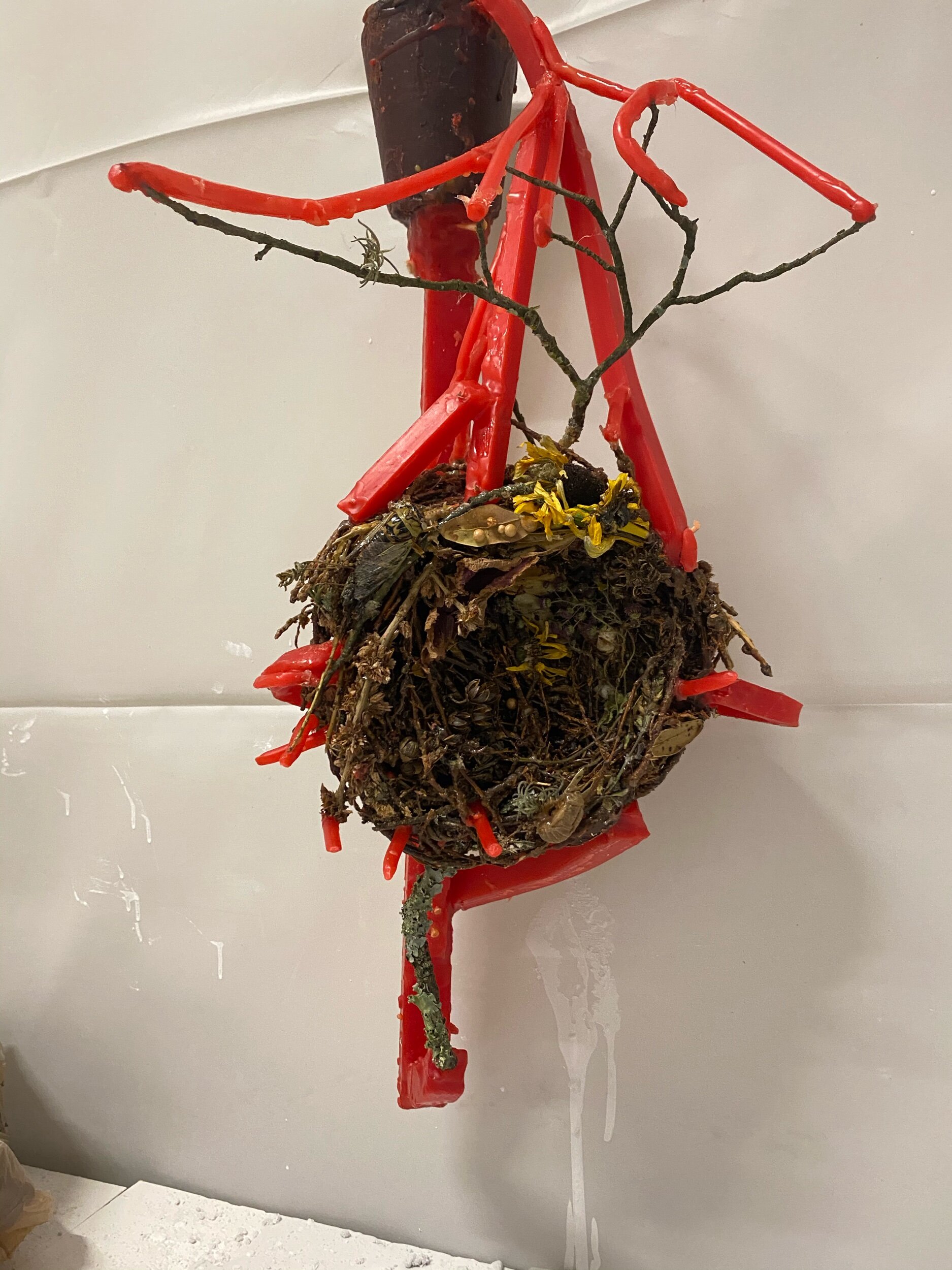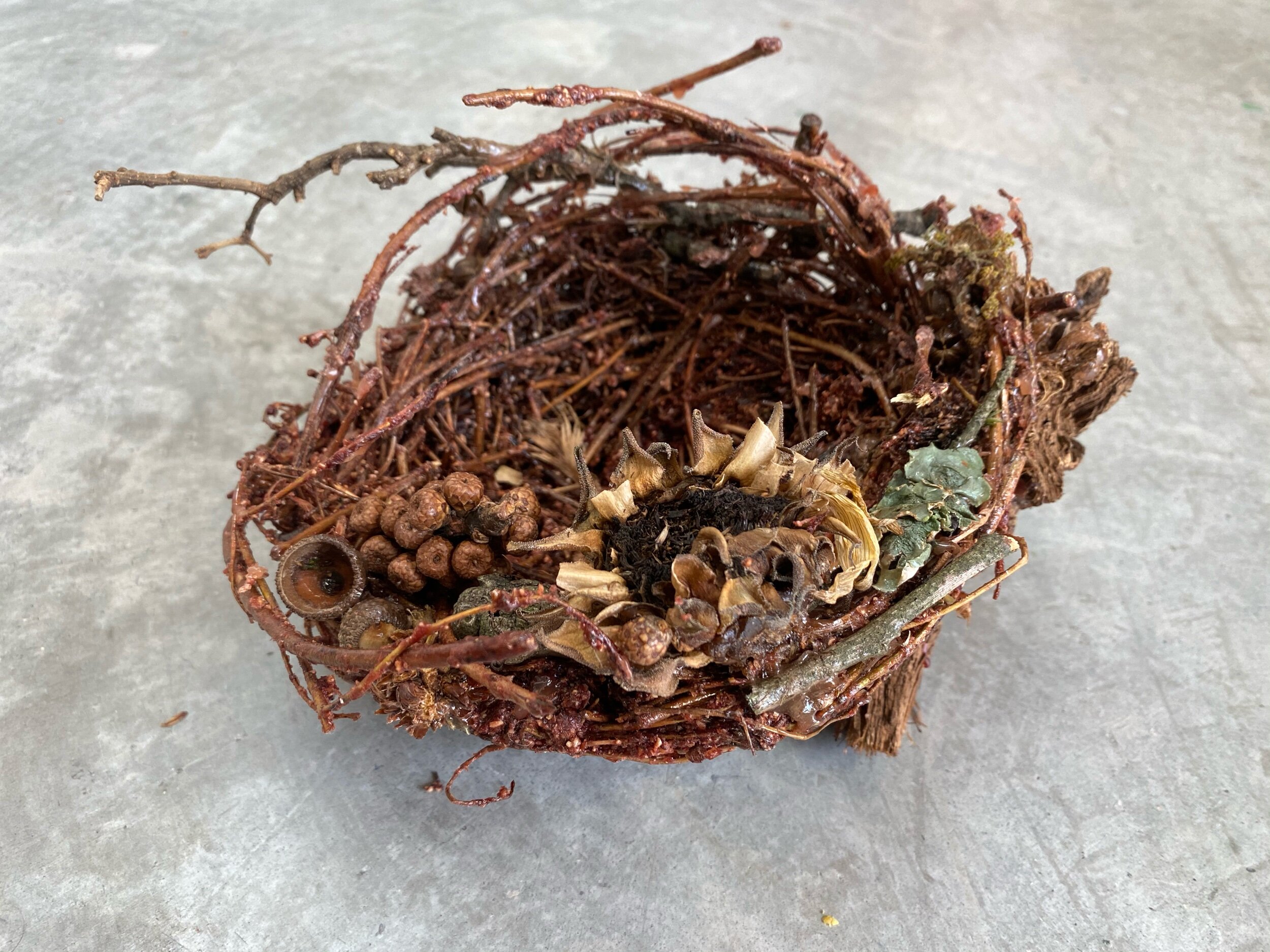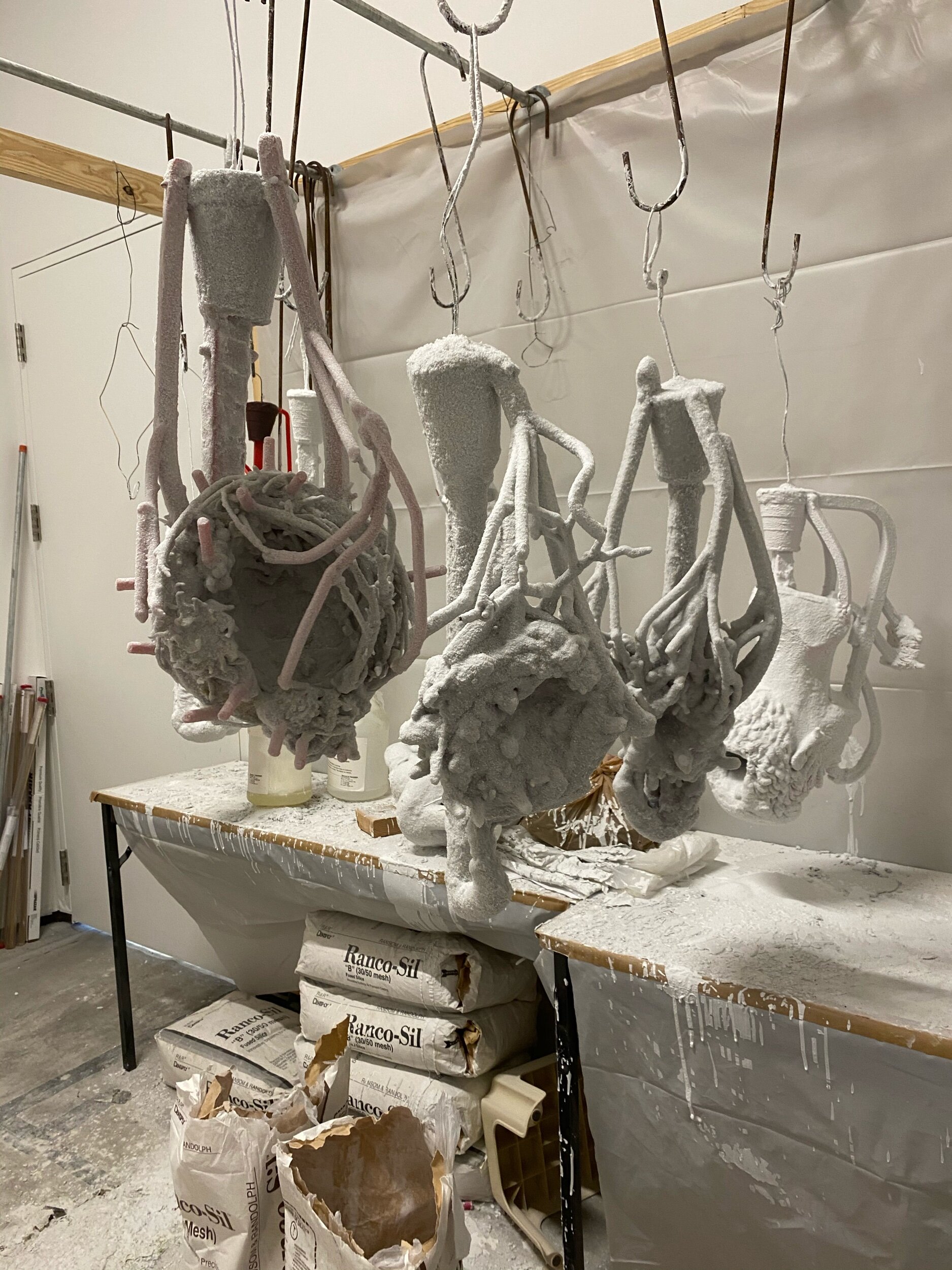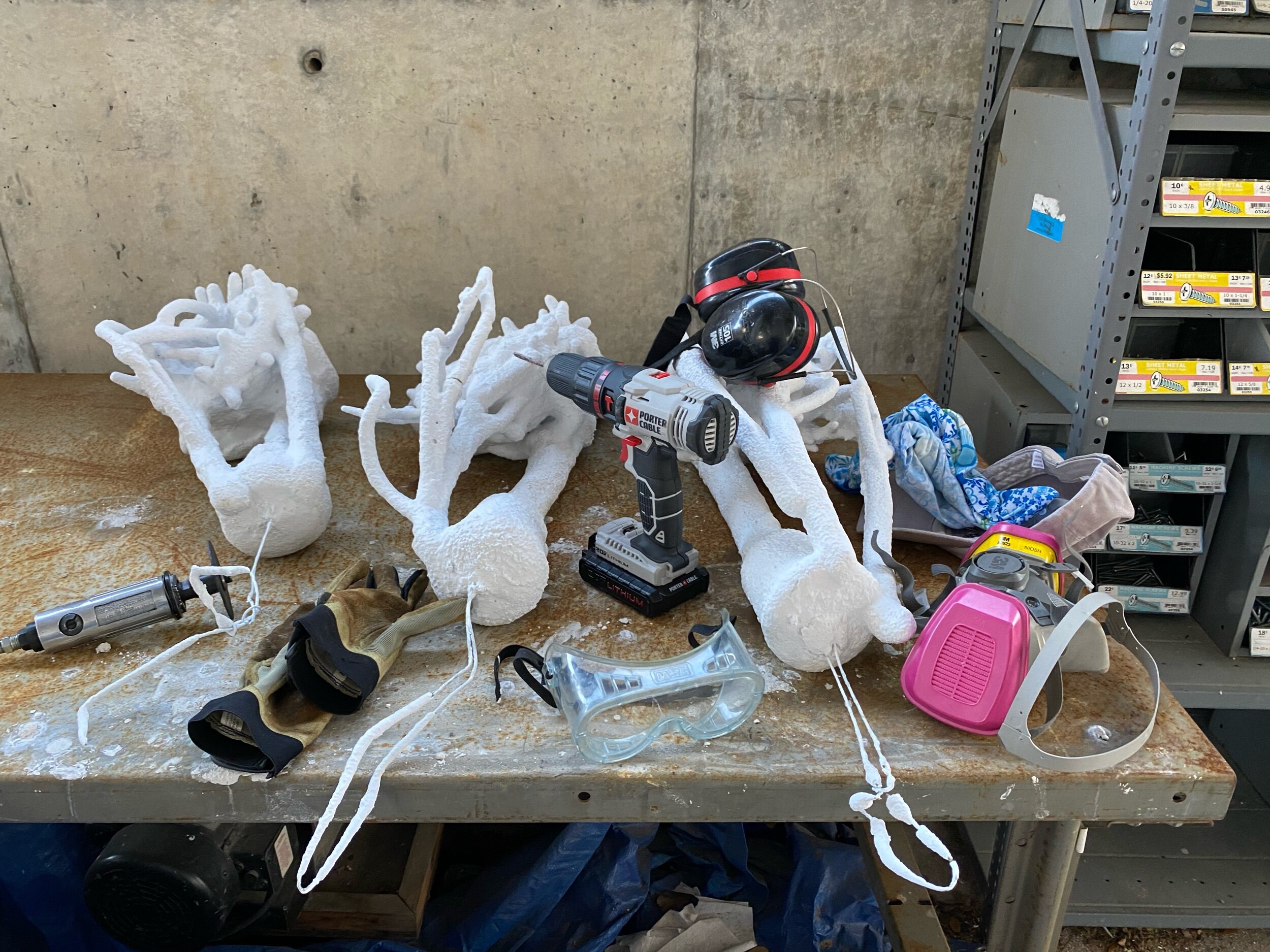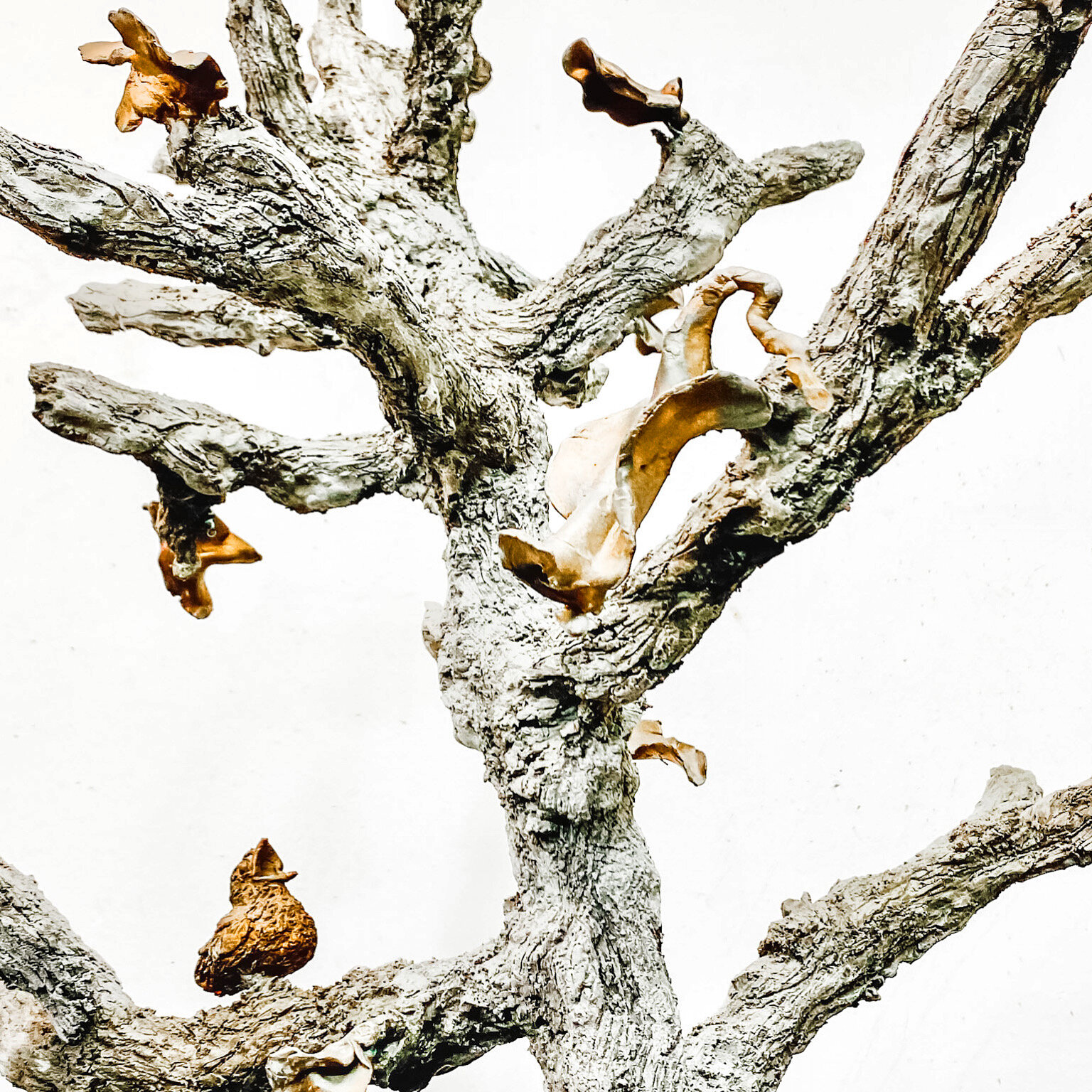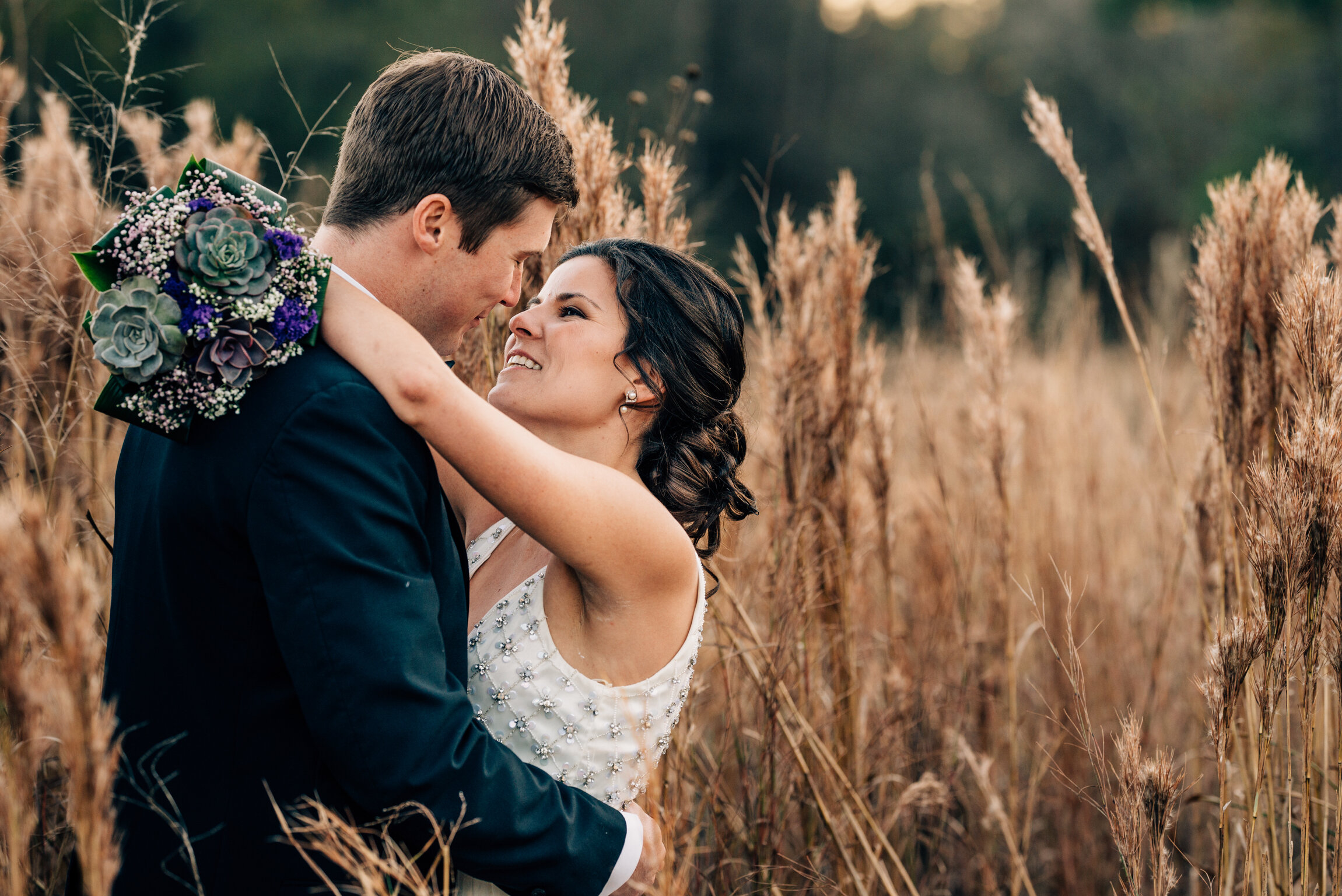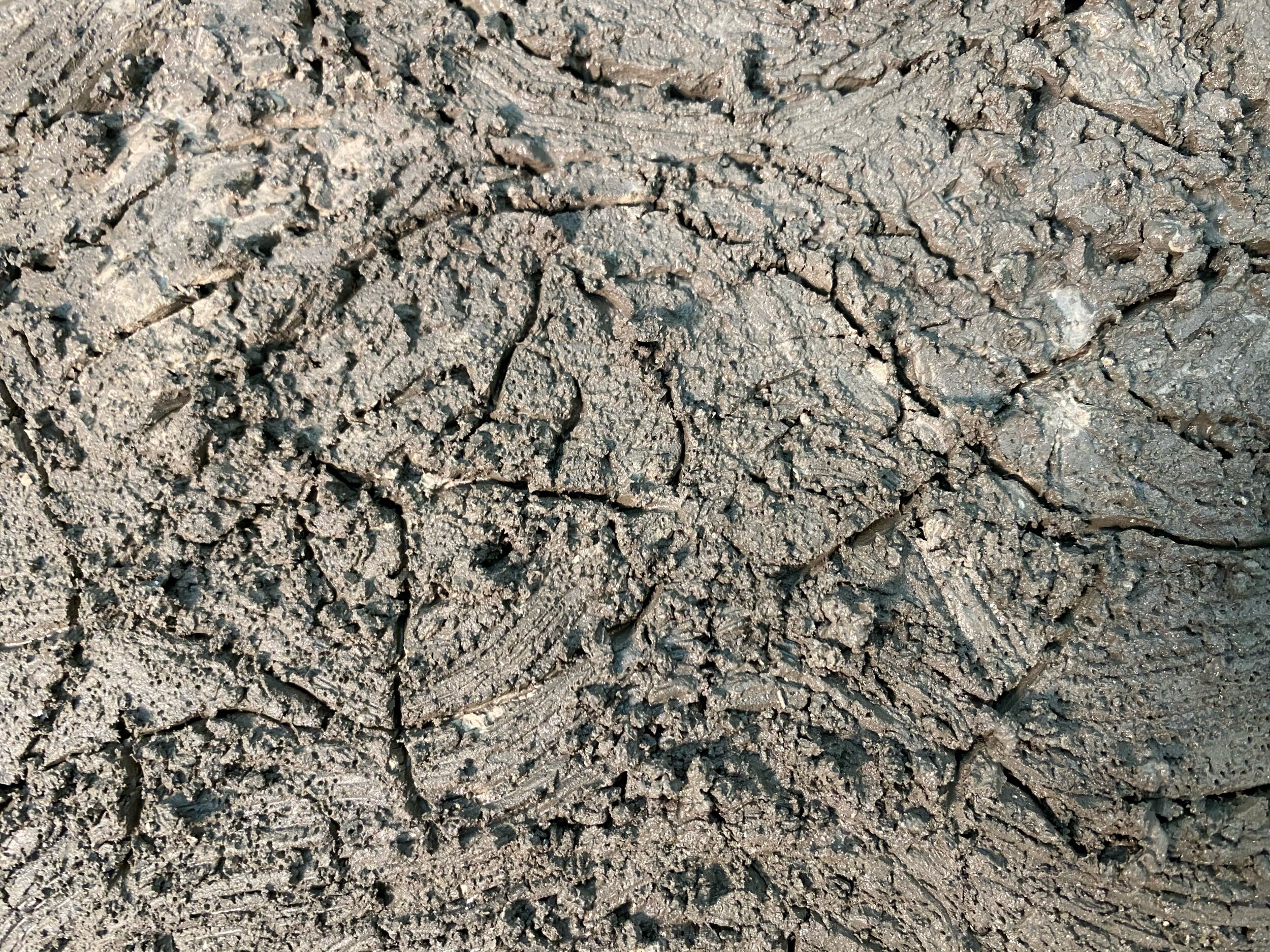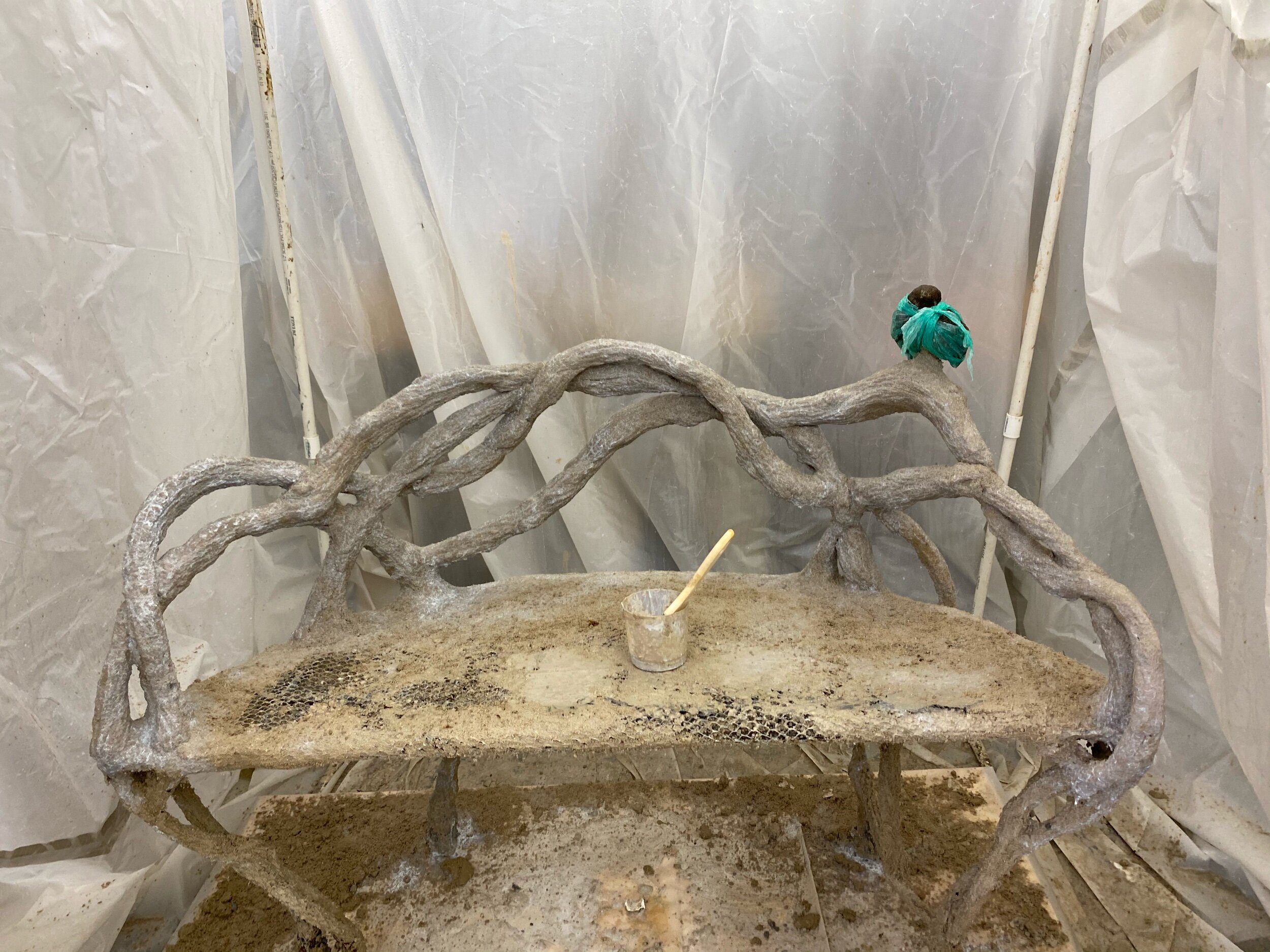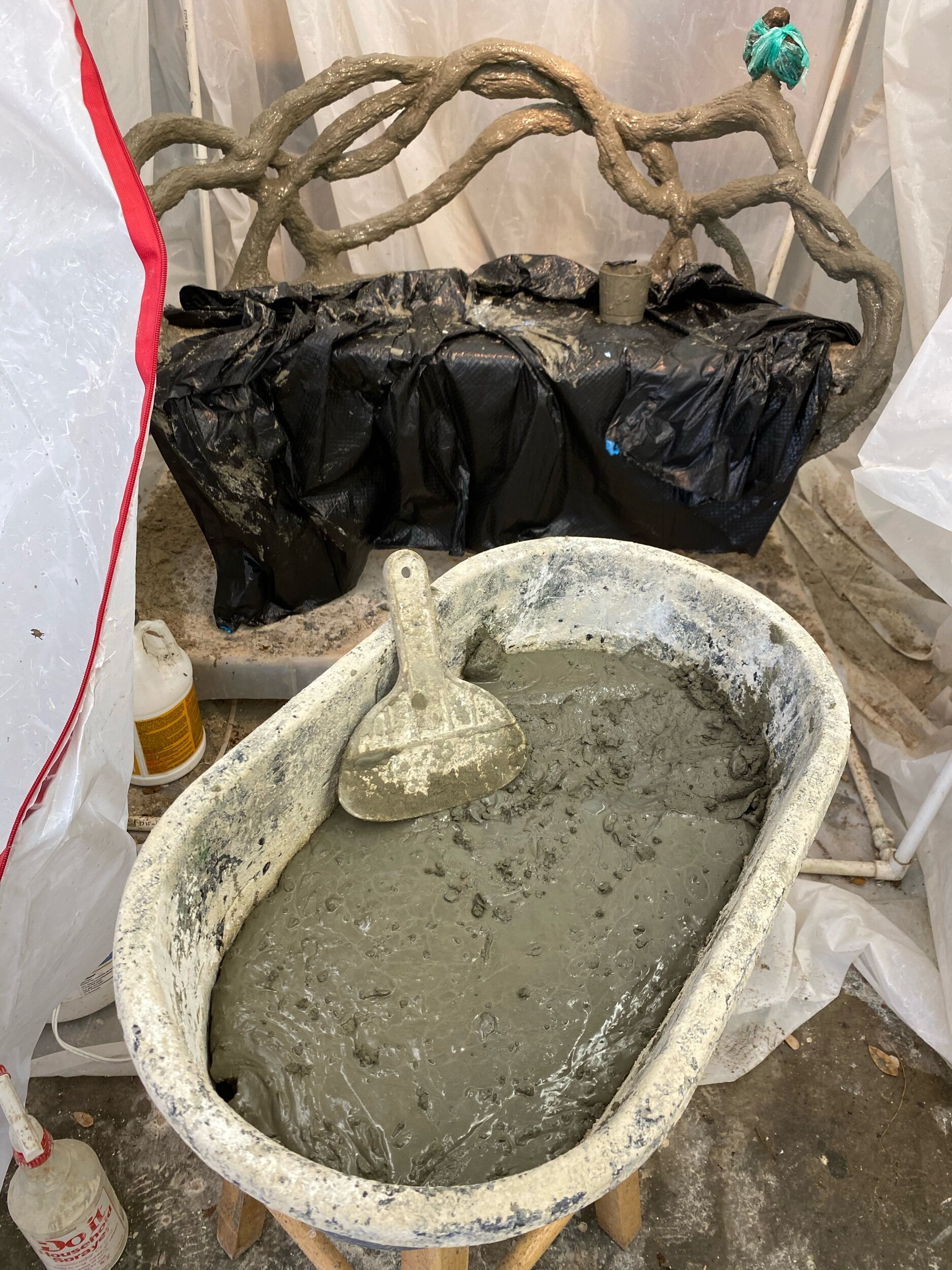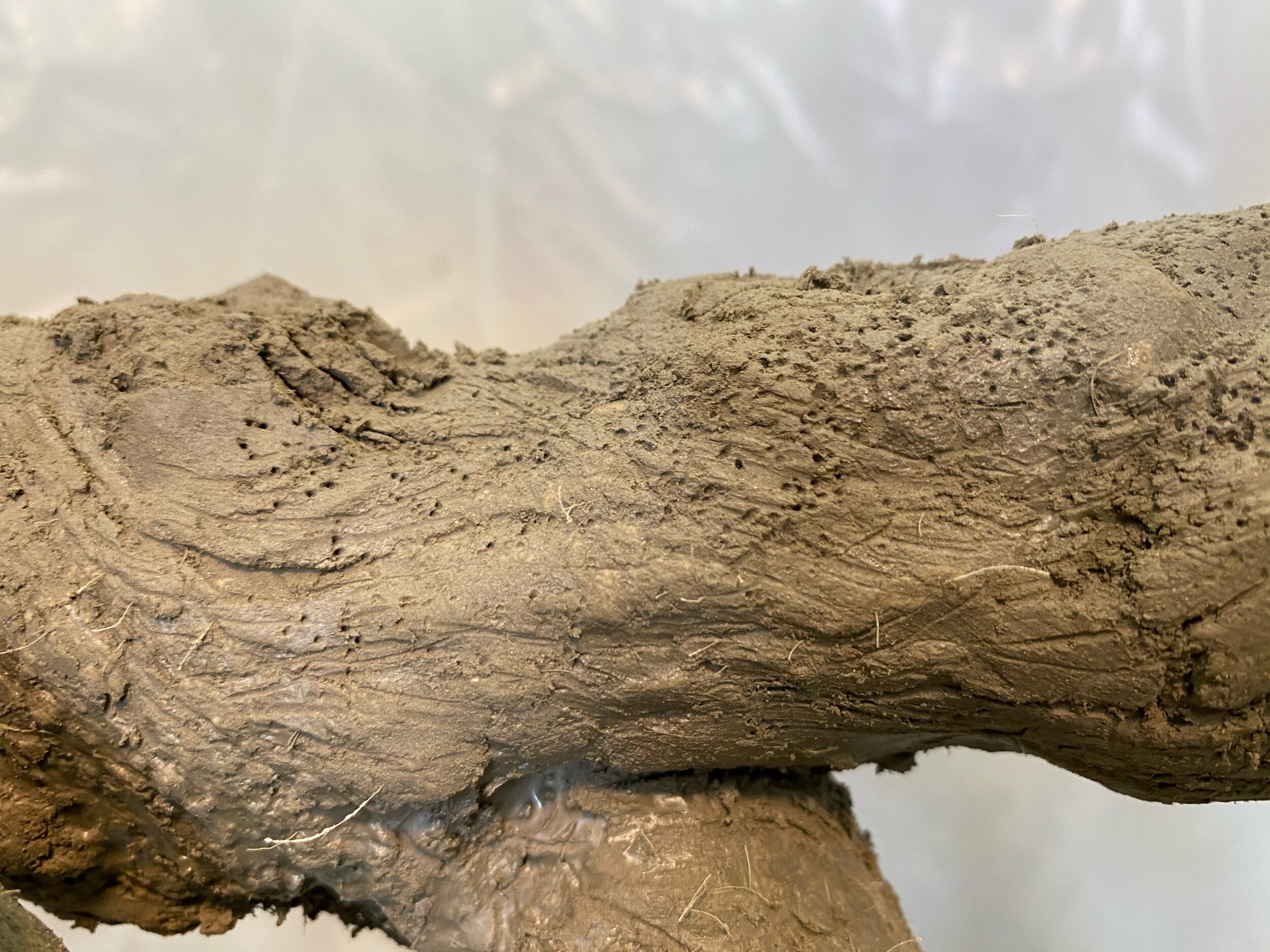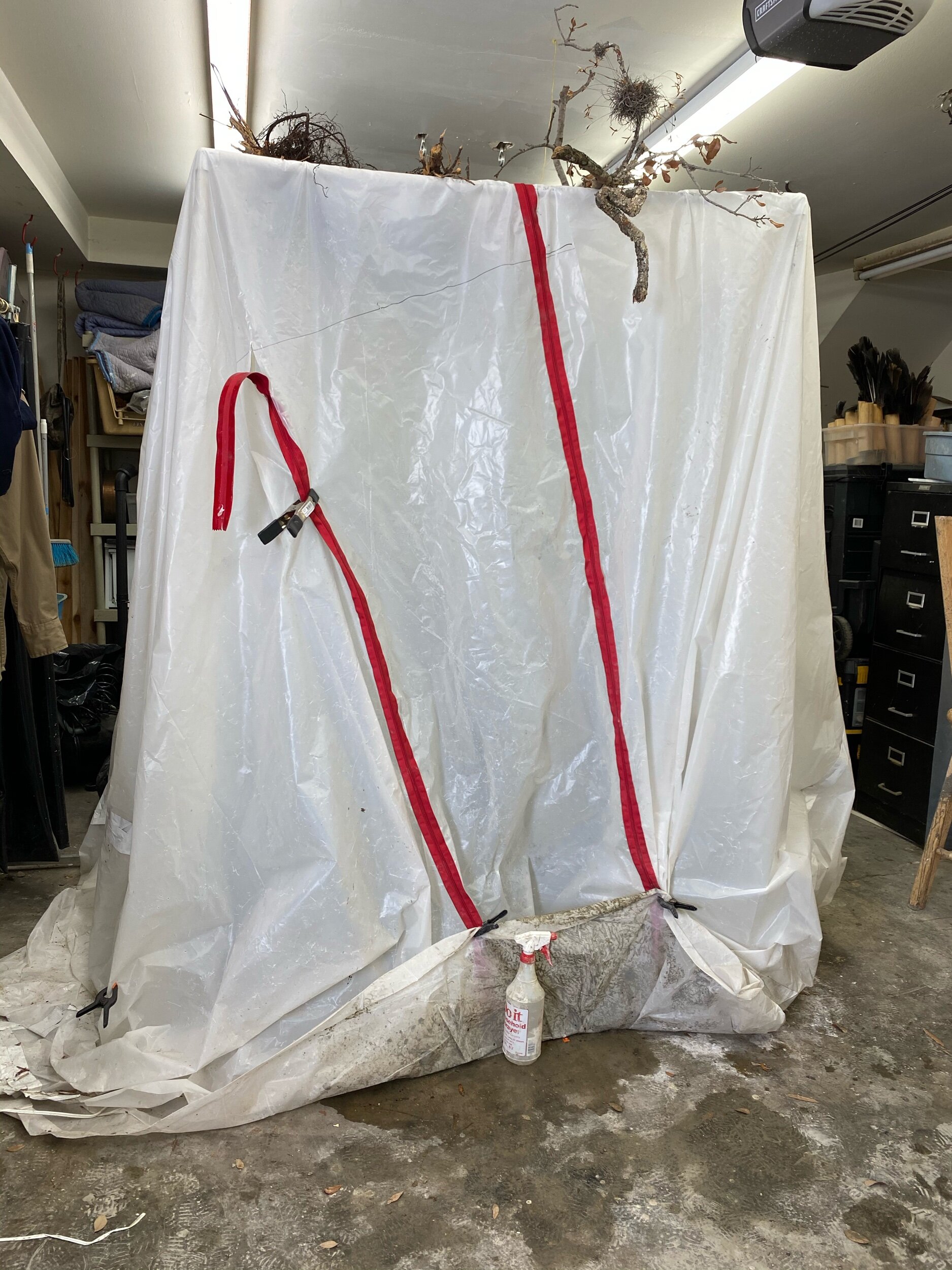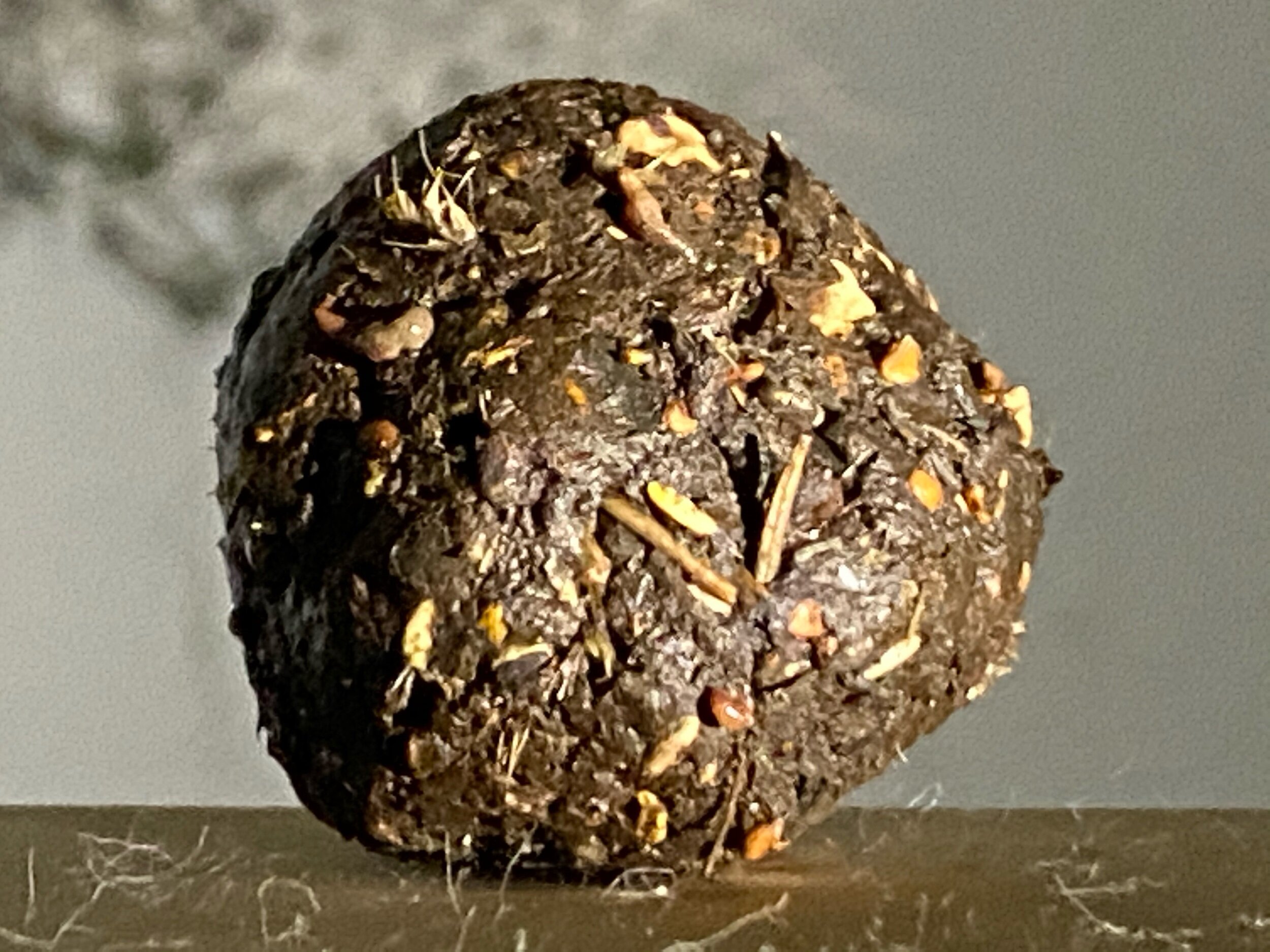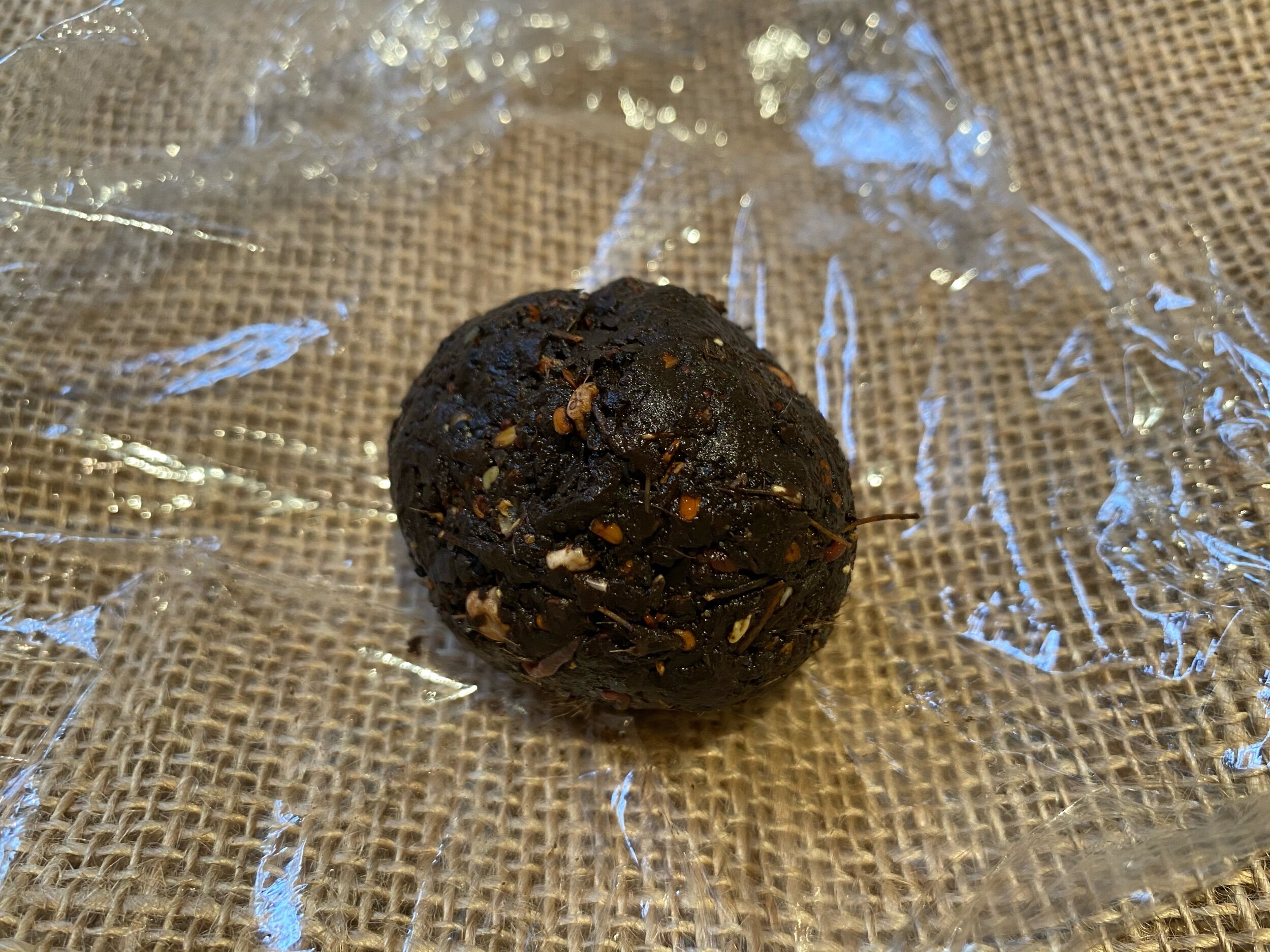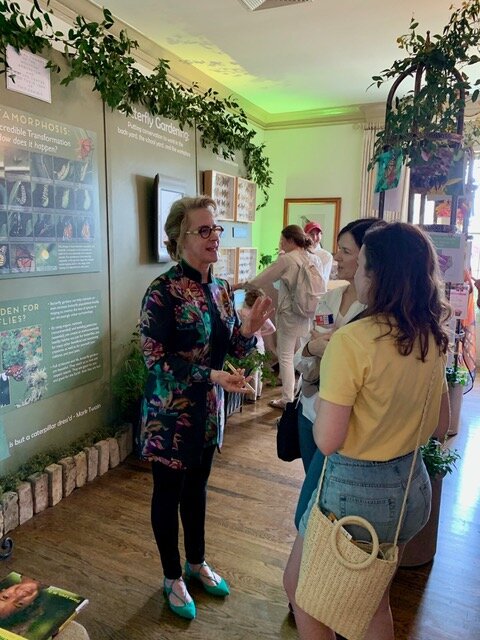I reached out to the Houston Arboretum describing my project and my need for native plants. They responded immediately. They are steadily cutting plants out and I made a big haul today. My studio floor is covered in drying plants. I am drying these on my patio. Curtis suggested every morning I flip them, so rodents don't decide to nest in them. I love all animals but I am not a fan of rodents nesting around my house. They offered me to raid their compost bend as I need. :)
Lawndale- dream opportunity
I have shared ideas regarding environmental land art concepts with Stephanie over the past few years, and this spring Lawndale Art Center decided to allow me to see what I can do. After some time thinking about what the work should be, I verbally made a proposal recapped in the letter below. I am pumped about his opportunity, the Lawndale sculpture garden feels like a traditional front yard in anywhere USA. The sculpture garden is lovely, but this is the Coastal Prairie, and Coastal Prairie landscapes offer many environmental benefits. I am addressing many of them in Endangered Knowledge: The Soul of Humus. This Lawndale piece will provide an example of a native plant landscaped area of the same scale as their yard. People need a project they can mimic. They can see native landscaping at the Arboretum, Katy Prairie Conservancy, and Buffalo Bayou. Those sites are enormous tracts of land, and most people can not visualize those landscapes in front of their homes. The Lawndale Sculpture Garden will be instrumental in communicating what a reimagined urban native landscape can be. It will inspire change.
Emily, Stephanie, and Will,
First, I want to introduce you to Will Isbell and thank you for meeting with me regarding the Lawndale Sculpture Garden, again. Now that I have had time to think about the space in the greater picture, I am proposing that Will Isbell, work with me to create a plan that will reimagine the Lawndale Sculpture garden as a work of living land art. Will is an artist, past President of the Harris County Master Gardeners Association, oversees the Family Garden at McGovern Centennial Gardens and makes educational videos for Herman park and works at Sicardi Gallery. I have pasted for your enjoyment a link to an Educational video Cooking From Your Garden that Will created a few weeks ago. Will's knowledge, credentials, and experience as a sculptor and gallerist at Sicardi Gallery will be extremely valuable to the project from conception to funding.
Will and I had initial discussions regarding the space last Friday evening, and we are like-minded regarding our landscape philosophies and vision for Lawndale's Sculpture Garden. As artists, we see our involvement as sculptors of a living piece of land art and environmental art activist. The long-term goal of our land art will be to take the garden from it's beautiful traditional landscaped state to a holistic living sculpture garden that works with the Coastal Prairie native landscape and, at the same time, showcases Lawndales sculpture exhibits. The living land art will be educational, functional as an exhibition space, and an environmentally healthy ecosystem/habitat. It will be groundbreaking in the art community to have a sculpture garden that showcases work in an ecologically conscious native landscape and will save Lawndale future dollars.
The first step is to get Will and I the landscape and irrigation plans and a key to the outdoor garden closet. Will and I will then do the research to reimagine the space and give you a conceptual proposal. If you are on board with our vision, we can then work with you on creating a site plan, securing funding, installation/timing plan, and estimate the volunteers needed. We are aware that this may be a long term staged project but are hopeful that it can be realized in the short term.
I am also looking forward to creating a piece that addresses the connection between humans, the natural world, and landscapes. Emily and I discussed that we should discuss the details of this future piece after my Sculpture Month Houston opening on October 10th. I would like to add the growth I realize as an artist from my experience creating the sculpture Month piece to my future Lawndale installation.
I am grateful for the opportunity to work with all of you and know this is going to be an amazing experience.
This is Will’s cooking from the garden video
Best,
Cindee
It will be groundbreaking to look at sculpture in a landscape unique to Houston Texas. .
Endangered Knowledge: The Soul of Humus - #2 A closer look at the materials I have so far.
I am in love with these textures and I can hardly wait to incorporate them into my Endangered Knowledge piece. I do need to figure out how to fade the green out. I do not want a green bison. I think the answer is sunlight.
Endangered Knowledge: The Soul of Humus -#1b Collecting raw materials
A peak in n my studio rich with native plants drying
I reached out to the Katy Prairie Conservancy, and they put me in touch with Bill Stransky with the Texas Rice Coalition, Bill a founder of the Katy Prairie Conservancy is a rock star in the nature Conservancy world. He very kindly offered to help me identify native grasses. He met me on a Sunday morning with his college-age daughters and not only pointed out native plants, but they helped me cut and bag them. It was such an honor to meet him and have him support my environmental work. I can not finish these piece without help in accessing native plants. It was a great day. I am hoping to meet Bill again in the fall when the rice plants are ready to harvest. It is important I have rice grasses since the exhibitiion space is a Success rice grain silo. The plants we harvested are presently drying in ny studio. My studio smells like heaven covered in plants. It is also the new home to a few spiders.
Bill Stransky and his daughters.
A bag of prairie seed mix. - donated by Bill to my project
The mix-
A new studio mate.
This is just the beginning, I need a lot more plants to dry for this large old male beast.
Same Time Next Year 2017, 2018, 2019
Same Time Next Year, is an annual survey of organic found objects preserved in the form of a bird’s nest cast in bronze. I retrieved these objects in a given year. I started making these modern-day fossils in 2013; each piece is a smidgen of a historical record of the natural world found in urban Texas. I include things I pick up gardening, walking my dog, flipping my compost bin, and daily outdoor chores. They are things that find me; I never go out hunting for them however I am always looking. Neighborhoods today are exceptionally manicured to the point of being sterile as opposed to full of life. Mosquito home misting machines and heavy weed control chemical additives keep the insects, birds and available organic matter relatively bland. I am campaigning to change the landscapes of urban settings. One day I hope there will be a greater diversity of found materials.
This year I am playing catch up and created the pieces for years 2017, 2018, 2019, in these pieces, there are bug casings, dried flowers, bug carcasses, twigs, wings, feathers, leaves, seeds a beetle, cicada and a dead bee. In January - March, I coated them in wax, sprued them up, dipped them to make the shell, and did two burnouts at the MFAH Glassell studio school foundry, and then the COVID 19 quarantine kicked in.
The MFAH responsibly closed the school but allowed us to pick up any work. I picked up the shells and took them to Legacy Fine Arts Foundry. They are great people, I have used them on several occasions on projects over the last six years. Their work is phenomenal; they finished burning out the shells and cast them, broke off the shells, cut off the sprues, and sandblasted the nests. I could break off the shells, but I have torn my shoulder twice, breaking off shells. I am so grateful for their help and enjoy working with them. I am excited to have the pieces cast, and I am ready to do the finish work and patina.
Below are the images I took as I worked on the three nests.
Shaping the dried organic matter.
Creating a system to get bronze into the sculpture.
The best with the wax sorue system.
The sprue system after the first dip in slurry.
All three pieces after several dips.
Drying after the last dip to build the shell.
My tools to cut off the top of the cup and blind vents. The wax will drain out if the tuop of the cup. I also drill holes to keep the shell from cracking as the wax expands in the furnace.
After cutting the cup and blind vents.
The pieces at legacy as Victor is breaking off the shells.
The three nests and some small bronze casting to use for studio visit gifts.
Nash Baker is my art photgrapher, Nash lost his photography studio to a fire studio during COVID. I will wait to have these pieces photographed when he is back in operation.
Sapling #8 to kindling - finishing touches
It needs a light sanding, a patina on the bronze and the concrete.
Sapling #7 - lath, 1st coat and second coat. (Copy)
My daughter special requested this piece. She asked if I could make her a sapling. My response was I could try, but the pencil size steel limits how thin I can make the tree limbs. Long story short, the sapling grew old fast. After the first coat the sapling limbs we're no longer sapling thin.
Covered in lath
Keeping an eye on my mix
The first coat - the bronze leaves are covered in green plastic to protect them.
First, I paint on the bonding liquid.
The piece is now ready for coat number 2.
Coat number 2 ✅
Here is the image edited super light in order to show the texture.
More details
Detail of upper branches
A little more concrete need under the bird.
Detail of trunk
The lower trunk and base.
The abundance of knots is evidence that this tree is the host of many insects and good bacteria. Bees and other insects use trees for nesting and receive antiviral properties from the fungus and bacteria that grow on the tree.
Faux bois Wedding gift ❤️❤️#20
The hard work is done. I did a little sanding on the seat so it won’t snag anyone clothes and then I was able to get some help moving it to a place where I can stand back and look at the work.
Front and reflection in the pond
Back view
Bronze
Lovebirds back
Left side view
Left back leg
Back right leg
Another view of the back right legs
Back right view of right legs
Back branch
Back left where back branches and legs connect
Front right legs - I love their hug
the seat texture
A piece of metal that was in my Dad’s ashes and his last name - Travis carved to the right of the metal bolt. I am guessing it is from one of his four hip replacements.
Griffin and Alex after their vows. - the lovebirds January 3, 2018
They will be in Houston for two weeks for Sage and Cameron Cuenods legal wedding vows June 12, 2020.
I Am looking forward to showing it to them. And I would like their opinion regarding a stain/patina.
Rumblings-Augochloropsis anonyma
In the past years blogging about my art practice was something I did everyday. It is how I document ny work. Then I started focusing on bees and their role in urban environments. Idecide to post a cool fact about native bees in my daily art post. Researching what fact to post bees has been like falling through the looking glass. I like to really get into whatever it is I am getting into. As a result the summer of 2019 Curtis and I binged watched bee documentaries. Sadly these are all about honey bees. I read every article that pops up on bees. I am constantly amazed at how much is unknown about this everyday insect. It has been so overwhelming I stopped posting information about the bees. I just could not pick just one cool thing to post a day.
There is very little information available about the Augochloropsis anonyma which is very frustrating. They are a sweat bee and there is a fair amount known about the sweat bees; they are a brilliant metallic blue-green color and one of the 140 members of the Halictidae family.
The earned the nickname sweat bees because they are attracted to sweat. With this information it is good to know they are not aggressive. They will only sting if you press them into your skin. If you are studying bees or garden and don’t want them to land on you wipe off the sweat and they will leave you alone. Please don’t hurt them. They are essential wild native bees.
You have probably seen one flying around wildflowers and various crops, including stone fruits, alfalfa and sunflowers but did not know you were seeing a bee. They are known as generalist and will pollinate almost anything. These bees fly under the radar, Being extremely tiny they measure only 0.125 to 0.5 inches in length they. You have to keep your eye out to notice this keystone creature.
Besides being generalist I see them as important because Augochloropsis anonyma adults have a long window of activity, and produce more than two generations of offspring a year. They are active between April and September in the northern portion of their range and year-round in its southern range. Having this long window of activity makes this species more likely to forage from a large number of different plants.
Art Activist and City council woman #2
This was awesome to receive, I am feeling hopeful. It is amazing to have a city Council Woman who cares and listens to citizens opinions. Screenshot from my phone email.
Sally and Hannah
The video of the FY21 budget workshop-Parks and Recreation was very informative.
Here is what I got out of the video that will help you move the city in an environmentally forward direction. I have broken it down into five steps.
Steve Wright knows the value of native plants and grasses. He expressed that he would like to move more in that direction. He does not because the public is not educated. With Steve on board, this is a great opportunity, and the timing is perfect. Sally, it is great you identified this opportunity, by leading Steve you can save the city money and the planet.
Step One – In Steve's presentation, #5 Greenspace Management (GSM), the city is spending $2,000,000 on mowing esplanades, and in #15 Quality Assurance, they spend $2,500,000 for safety training to maintain the esplanades. Making all esplanades native grasses is a change that will free up a significant amount of money and help all insects as well as the bee. With Covid 19 sucking the life out of the country, the financial savings alone is reason enough to make the transition. This change will start the education of the citizens. Now is the time to take the first step in making Houston a leading city in environmental policy and help with the budget.
Step Two – Steve did not mention the chemical additives or equipment the city uses. City Parks and Recreation would also save money on the chemicals used on manicured landscapes such as herbicides, pesticides, fungicides, and neonicotinoids. This change would also impact the dollars spent on equipment and fuel for lawnmowers. Have Steve add that number up for you.
Step Three- Have Steve's people look at every area they manage: the city libraries, trails, parks, sports fields, golf courses. The zoo should also be charged with evaluating its grounds. Have them identify pockets in these city public spaces where they can save money by transitioning to native plants. There is a lot of precedent in other cities for native plant golf courses. Golf courses use an extreme amount of labor and chemicals; this could be a significant number in the budget.
Step Four – Steve mentioned Public Works land. It was not clear whose budget it is in, but it should be maintained in an environmentally forward thinking manner.
Step Five – Steve was concerned about the public's knowledge of the benefits of native landscaping versus the mindless conformity of the manicured landscapes that we are used to seeing. This education is a project for his new social media employee. In addition, the Mayor should call a press conference and make a big deal of the City Councils' commitment to not only the health of it’s citizens but also the environment and not mindlessly conforming to unhealthy chemically dependent landscape practices and to saving Houstonians a lot of money. The Mayor can also go into the benefits of restoring native prairie vegetation as it decreases water runoff and flooding, increases soil absorption of water and slows floodwaters on land.
A press conference is excellent advertising. It can also be addressed on the citiy’s website.
If you need inspiration, look at the 5/2020 National Geographic, Where Have All the Insects Gone? Pp. 40-65. The article is a study from 1989 to 2016 of flying insects. The study reported a 70% decline. You will find quotes such as "ecological Armageddon", "we find ourselves in the middle of a nightmare", "According to the website Altmetric, which tracks how often publish research is mentioned online, the study was the sixth most discussed scientific paper in 2017."
Insects do the dirty work for us; they pollinate, disperse seeds, are food for freshwater fish, and about every land animal, from reptiles to birds. They decompose our waste; without insects dead, organic matter will pile up. N. G reported the work insects do is equivalent to $57 billion a year in the US.
After you tackle the City Parks, we can look at residential and commerci
Endangered Knowledge: The Soul of Humus #1a and Sculpture Month Houston
In a moment of global uncertainty, I ask myself, what materials would I use to leave a message for future civilizations? As I think of artists who painted caves, of muralists from the past, of artifacts from ancient civilizations, I am curious about how we leave a mark. My answer is tied to the natural world: much of my previous work has been about conservation issues, looking specifically at bees, at waterways, at recovery from Hurricane Harvey, at bison and now, at grass. And so, if I were to write a message to the future, I would use grass to write it, and bison to carry the message.
Endangered Knowledge: The Soul of Humus
For this year's Sculpture Month, I propose a site-specific sculpture of a bison, made from a welded steel armature, a work of land art covered in topsoil and dried native grasses. This is part of a comprehensive installation that I am currently developing, which considers the role of the American bison within Houston's specific soil ecological history. The work is titled Endangered Knowledge: The Soul of Humus.
It is inspired by the words of M. Thomashow, who writes, "Record natural history to the collective memory so that it is no longer endangered knowledge." For several years, I have been researching grass-fed food production, attending soil conferences, and visiting regenerative ranches. Research in these fields show how to fight desertification and reverse climate change through regenerative agriculture practices. Interestingly, this natural history of living soil, how it evolved in the Houston Coastal Prairie, and its essential part within microbial communities in human health, is not common knowledge.
Description of Work
In the hide of a sculpture, I tell the narrative of soil health. My sculpture will record this endangered natural history through the dense coat of the powerful humus-built bison, that will be dripping in the armor of locally sourced dried native grasses and sedges, seeds, and pods. The male bison will be supported by a welded steel armature, covered in a stainless-steel lath. The bison's skin, made from these dried grasses, will be attached to the lath with a Houston mud composite. I propose the 11' long bison be exhibited in the center of a large grain silo, the bison in an actively grazing stance, head down in plow position, his hump rising robust and bushy out of his heavy forequarters to 6.5' tall. Lighted from inside the grain silo funnel, viewers can approach the bison and intimately inspect the diversity of the native plants implanted in its pelt.
Ecological History
Historically B. bison functioned as the first farm equipment. The grass seeds clinging to their burly coats were carried across the plains as they migrated north to south and back between seasons, like tractors up and down fields. Herds of tractors not green, but a rich brown harvested the plains with their appetites, each bite stimulating new root growth. The old roots withered into cavities that served as dwellings for a variety of keystone species, and became underground cisterns collecting floodwaters for drier seasons. Their coats dropped kernels and cuttings as the winds ruffled their beards and chaps, and when they took dirt baths in buffalo wallows dug with their horns. Massive roaming compostors, a single bison cow daily dumping 40 lbs. of fresh manure onto these seeds and drilling them into the earth with their spade-like hooves, sprinkling them with the perfect prescription of nitrogen, phosphorus, and potassium-rich urine and then moving in a predator safe tight herd on to the next buffet. With time the newly sowed fields sprouted new growth of blades, stems, and leaves of countless shapes, sizes, and heights. This diversity of leaves fit like puzzle pieces into dense living solar blankets, harnessing carbon from the air and returning it as sugars to feed the dynamic root microbiomes below the earth’s skin. The complicated relationship between the soil microbiome and the human intestinal microbiome is one of the most dynamic topics in biomedical research. Flocks of birds mutualistically
living off the pests harbored on the bison followed the herds, drinking from and bathing in rainwaters that collected in the bison wallows, building their nests from clumps of bison fur. Recent studies show the fur provides a health benefit to unborn chicks. Bird and butterfly habitats were abundant when the bison roamed.
Relevance
Global warming, food security, drought/flooding, wildlife habitats, economic instability, and health – these problems are not new to humankind. The archeology of ancient civilizations has recorded connections between the longevity of civilizations and the health of their soil. The United Nations reported in 2014 that the world's topsoil would only last 60 more growing seasons. Soil scientists around the globe agree that solutions to these issues are rooted in our treatment of soil—the skin that covers our planet.
Message to the Future
The armor that protects the epidermis in the Gulf Coast prairie is grass. The animal whose population peaked at 30 million, is B. Bison. Combine native grasses with ruminants and the grasslands decompose into rich organic matter; for every 1% increase per acre of biological organic material, the soil can hold an additional 20,000 gallons of water. Restoring native prairie vegetation decreases water runoff and flooding, increasing soil absorption of water and slowing floodwaters on land. With extreme building practices and concrete hardscaping, reimagining the landscape of Houston's 600 square miles of real estate can make a significant impact on the region’s flooding. The prairie grasses' roots can extend from eight to fourteen feet deep: these roots sequester carbon like an upside-down rainforest. Changing our agricultural practices is an important step towards turning global warming right side up. Telling the dynamic story about these relationships between the grazing herds, the living soil, and finding ways to reimagine urban landscapes and agricultural practices in holistic and regenerative ways are the center of my current research and sculptural practice.
The impact of the bison on sustaining topsoil—and, therefore, life—need not be Endangered Knowledge. The role bison play within the prairie ecosystem—their ability to increase photosynthesis, reduce competition for water, and regenerate depleted, unsalvageable, lifeless prairies back to productive and bountiful, nutrient-producing land and wildlife habitats—needs to be carved into our modern systems. Recording this Endangered Knowledge into the consciousness of humankind will stimulate grassroots efforts and stop the cultivation of soil depletion and return the natural process to the treatment of the skin of our planet. A Parietal artist in 2020, I will use grass to record the Soul of Humus so that it will no longer be Endangered Knowledge.
Additional work
Soul of Humus will be the first piece in my Endangered Knowledge body of work. The complete body of work will eventually consist of the following sculptures: 4 pedestal-shaped sculptures of roots and soil, measuring approximately 12" X 12" X 36"; installations made from native grasses and their roots (size and number to be determined); 1-5 bronze castings of bison dung with their spade-shaped hoof prints, dung beetles, and mushrooms. I am also currently in conversation with a bison rancher to secure a bison heart to float in a glass case of formaldehyde: the bison, the largest mammal of the western continent, is the heart of our soil diversity, it is the western symbol of a healthy planet. The health and longevity of civilization, as we know it, is dependent on finding ways to mimic the natural process stampeded into the bayous of Houston. In this sculptural series, I look closely at the components of this process and the environmental interrelationships unique to the Houston area and world health.
Footnote-
Bison vs Buffalo which name is correct? The common name Buffalo has been widely used, since early settlers were naming them as their European and Asian counterparts. The correct name of the last American surviving bison is B. Bison.
Further Reading and information –
- Allan Savory on how to fight desertification and reverse climate change
- Soil as Carbon Storehouse: New Weapon in Climate Fight? - Yale E360
- A Prehistory of Houston and Southeast Texas,– D. Worrall, coming fall 2020
- Can Livestock Grazing Stop Desertification?
https://www.scientificamerican.com/article/can-livestock-grazing-stop-desertification/
- Dirt: The Erosion of Civilizations, by David R. Montgomery
- Soil Biology and Land Management https://www.nrcs.usda.gov/Internet/FSE_DOCUMENTS/nrcs142p2_052489.pdf
- Wildlife that Depend on Bison
Sample Work and Visual Support Materials for Proposed Sculpture
Two small sculptures that are made with the same structure, process, and made with native plants-
The bison will be furrier than these small birds are and would be dripping in a thick coat of textured dried grasses.
Hay Day Peace Pigeon 2016
15” X 12” X 8”
welded steel armature, plaster and hay
Feathery Finery Peace Pigeon 2016
12” X 12” X 6”
steel armature, steel lath, plaster and plants
Three large sculptures that are made with the same armature and process, but I have used metal instead of dried plant cuttings on the surface for texture.
Broken 2018
40” X 29” X 55”
Welded steel armature, stainless steel lath, concrete, wire cloths and wire
Sonata in 4D 2018
6’6” X 5’5” X 5’
steel welded armature, stainless steel lath, plaster, wire cloths and wire
Bringing Home the Bacon 2019
66” X 42” 60”
welded steel armature, stainless steel lath, hydro stoner, wire cloths and wire
There are many textures of native grasses at the Katy Prairie Conservancy and Buffalo Bayou.
If you accept my proposal, I plan on asking the Katy Prairie Conservancy and the Buffalo Bayou Partnership to allow me to source my grasses and plants from their properties.
Sample of one of the many amazing textures on the various grasses and plants in the coastal prairies.
This shows the movement I am visualizing on the coat of the Bison
Below are Some of the source images I will use while sculpting the bison.
most of these I took doing research at Roam Ranch this summer, fall and winter.
This shows the position of the head I am looking for, it is grazing but you can see the face. This is a cow (female) My piece will be a burly big old male.
This is a large bull but it is not very old. My sculpture will be an old male that will have scrapped up and chipped horns from fighting and digging wallows and a massive thick (and dripping with dried grasses) big beard and chaps. This side view is pretty close to what I have in my head. I might have his head turned slightly to one side. That could be determined by which side of the building the silo would be on. The face will be more interesting and textured than the back side of the bison will be. My sculpture would be grazing on taller grasses. I would also raise his head for more eye contact
This is a good image of a bull’s face. Not my photo.
another view- not my image
Faux bois Wedding gift ❤️❤️#15
Today I poured 30 lbs. of white concrete and 29.5 lbs. of grey Portland for the seat. In the mix was .5 lbs. of the ashes of Robert Ira Travis, my dad. He was born on December 10, 1927 he passed away March 24, 2018. When I measured out the ashes thIs small metal piece was in his ashes. I think it must have been part of one of his four hip replacements or two knee replacements. It was like finding the toy in a box of cracker jacks. I think Griffin and Alex will enjoy it embedded in their piece.
Bolt, name and ashes of R.I. Travis.
I used the white concrete to create motion in the old wood.
I went a little crazy
The seat has lots of rings from burls in the plank. Griffin and Alex love bugs and mushrooms (the fruit of fungi) both of which cause burls. The seat of their bench is riddled with big burls.
A sweet knot with some severe old wood cracks.
Once the piece hydrates for 5 days I will take a sander and smooth down the seat.
I gave the birds a knot to perch on.
Another view of Bob Pa’s moment in the bench.
Every few hours I check on the marks to make sure they have not filled in. There is a lot of concrete on the seat and the white concrete is taking a long time to set.
Faux bois Wedding gift ❤️❤️#14
I was not happy with the results of last Thursday's work on the upper branches. The concrete was not sticking to the scratch coat. Afterwards I went through the past blog posts for this piece and this is not the first time I have had trouble with the cement sticking. I made note that the liquid part of the concrete mix was too old. Good to know, the best part of a blog is the documentation of the work. As a result of the old liquid the branches ended up lacking detail. That is what happens when one takes multiple year's to finish one project. Today's work looks better. It does have it's share of wormholes and I love wormholes. I am a sucker for any piece of old wood eaten up by worms. That is the beauty of old wood.
Wormholes and knots
Below is a photo journal of the process.
Mixing the wet part of the concrete mix.
Mixing concrete is very similar to baking, you have to measure every ingredient precisely and mix them in the correct order.
A sound concrete mixer is a must; hand-mixing concrete is just too physical. I love this machine. Behind the mixer you can see roots for future bronze pieces drying on the plant trellis
Fifteen minutes of mixing the dry ingredients.
While I wait for the dry ingredients to mix I paint a bonding agent onto the scratch coat.
A close up of the white bonding agent after application.
All branches are coated with the bonding agent and drying while I check on the cement mixer.
When you look closely you can see the fibers I put in the concrete last week. The fiberglass fibers help the new layers of concrete bind to the last coat.
Just like in baking, you pour just a little wet ingredients in the middle of the dry ingredients.
I clip a cardboard door to the mixer, to keep the dust down.
The mixer kicks up a lot of dust.
Even before ppe was a thing, I wore a respirator and a head covering when mixing cincrete. There is nothing like shampooing concrete dust out of your hair.
Here the mix is starting to stick together and make marble and golf size balls. Ut us about 1/2 way ready.
Ready to start applying the concrete to the branches.
First, I mix a little concrete with the white bonding agent and make a slurry. I paint the slurry mud into the branches to help the first coat stick. Then I wait for it to get tacky.
Another detail look. Some of the fibers from the prior coat are still sticking out. That is ok, when I am finished I will take a small torch Abd burn them off.
My hydrating tent is getting a bit caddy campus.
Five more days of hydrating and then I pour the cement for the seat.
Stitching a Sweat bee and incorporating time and movement
Another day of social distancing and not being able to get in my studio. Today's stitching, I added the first of several sweat bees. In reality, they are only about 1/4 ” long. They have beautiful metallic greens and blues. I am working to show more time and movement in my stitching.
I added a tiny sweat bee - he is moving fast and as a result blurry
First I cut some thread of the colors I want the bee to be.
Next I wad them up into a cocoon.
Then I untangle them into the shape of the movement of a bee.
Then I stitch them into the shape of the movement.
Sweat bees
I have had several people text me or Dm me to tell me about the bees they have seen this spring. That they are looking for bees during their Coronavirus afternoon walks. Some have was even said they would have killed the bees, except they knew I would not have been happy and that they need to protect the bees. It is so lovely to hear about these sightings. Thank you for the feedback- the role of an environmental activist artist can be frustrating at times. This feedback is inspiring. I love this native bee. Did you know this minuscule creature buzzing your native plants is a bee? I think it is a sweat bee part of the Halictidae family. There are 4,000 native bees and hard to identify. The Halictidae is the second largest family of Apoidea bees. Halictid species occur all over the world and are usually dark-colored and often metallic in appearance. With a macro lens, their colors are amazing. Several species are all or partly green, and a few are red; a number of them have yellow markings, especially the males, which commonly possess yellow faces, a pattern widespread among the various families of bees. (Source: Wikipedia, Halictidae, CC BY-SA 3.0) They are tough to photograph as they are swift and only about 1/4” - such a beautiful creature. Aren’t they cool.
Zoomed in
This gives you an idea how tiny these are.
Gorilla Art - native Wild flower bomb
Earlier in the year I sent the below letter to my City council representative. She is very supportive and agreed to review the Cities landscape ordinance and bring it up to date to reflect our current environmental situation as it pertains to native bees. The bees that are endangered, the honey bee is not endangered. I anticipate that with the health scare our city is facing our bees have been put on the back burner. Since the bees can’t wait for the c virus to die down, I decided I need to act. . Below is my letter. If you agree with me we need to all become gorilla artist and install texas wildflower seeds in every vacant spot we can. See my below post for how to be a gorilla artist and save the Native bees. If you want something done do it yourself. I still have hopes our city will reimagine our urban landscape and save the bees. #bees #houston #cindeeklementart #gorillaart Scientists predict that without pollinators, human life can only continue for four years. In 2017, the U.S. Fish and Wildlife Service listed the Rusty Patch Bumble Bee on the endangered species list. The campaign to list a species as endangered is lengthy and complicated. With this system it is difficult to gauge how many species are actually endangered. Bees are responsible for pollinating 75% of the world's flowering plants; they are crucial for the production of most fruits, nuts, and berries – that our agriculture depends on pollination by bees. Rural areas are highly impacted by the unanticipated consequences of our industrial agriculture’s dependence on chemicals that weaken bee’s immune systems. Urban bee populations can be more diverse than in rural areas. Researchers are finding in cities such as Chicago, Berlin, Berkley, and Melbourne that have reimagined their parks, neighborhoods, city centers, vacant lots, street medians, and rooftops planted with native flowers, grasses, and fruit, and vegetables support healthy, vibrant wild native bee populations. There are four thousand native bee species. They pollinate over three hundred times more effectively than honey bees. For example, A single female Leafcutter Bee visits 100,000 plus blossoms per day whereas a honey
Mix native wild flower or grasses seeds with soil. I am using a handful of compost from my bin.
Wrap it up so you can carry it and not get your hand muddy.
Find a place to throw it that will not be mowed. I picked behind this chain link fence, in the parking lot of my art studio.
Here she lays.
A closer look at - native wild flower seed bomb.
Three weeks later.
There are so many weeds sprouting up it is hard to see my seed bomb. But I see it. It does not have any blooms yet but my fingers are closed it will.
Since we are in quarantine I decided at this time to not make a bunch of bombs to share with others. I would love to share but I am erroring in the side of caution. i put the rest of my wild flower seeds in my flower beds that I needed more plants.
Azalea Trail and wild native bees
This summer it came to my attention that the River oaks Garden Club was having a luncheon with a bee theme. I quickly reached out to their luncheon Chair and she connected me to their environmental chairman. They came to my studio and we talked about the 4,000 wild bees species and how most people only know about honey bees.
Long story short I was invited to talk about the bees at their annual Azalea trail fundraiser. They were Slammed with people. I spoke none stop on Sunday from 11-5.
In addition the environmental chairs decided to work the native bee (the endangered bees) story into their both at their garden show this spring. It is organizations and ladies like these that can save the wild bees.
Image courtesy of Janna Webber
Falling through the bee looking glass #1
In the past years, blogging about my art practice was something I did every day. It is how I document my work. Then I started focusing on bees. At first, it was bees and the weed killer Glyphosphate.
The above pieces we're done in response to learning that Glyphosphate does not kill bees but impacts their immune system. With compromised immune systems bees subcome to disease. Glyphosphate is also now well known for causing cancer. I then made a five flip lenticular from these three images.
Copy of SITE Gallery- Sculpture Month Houston - Installing the work#2
Things are now going smoothly maybe too smoothly. All the work I did this summer is paying off.
